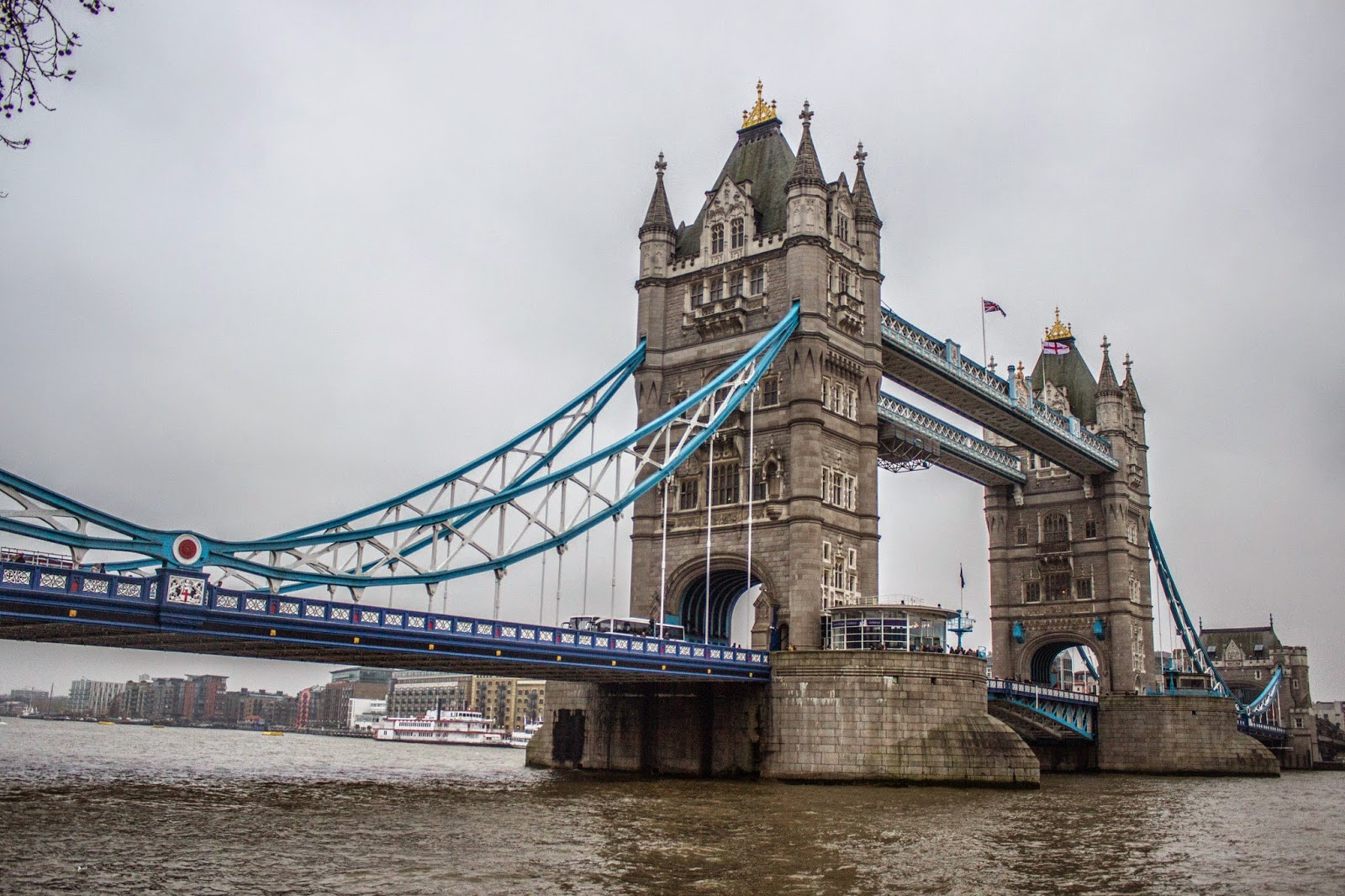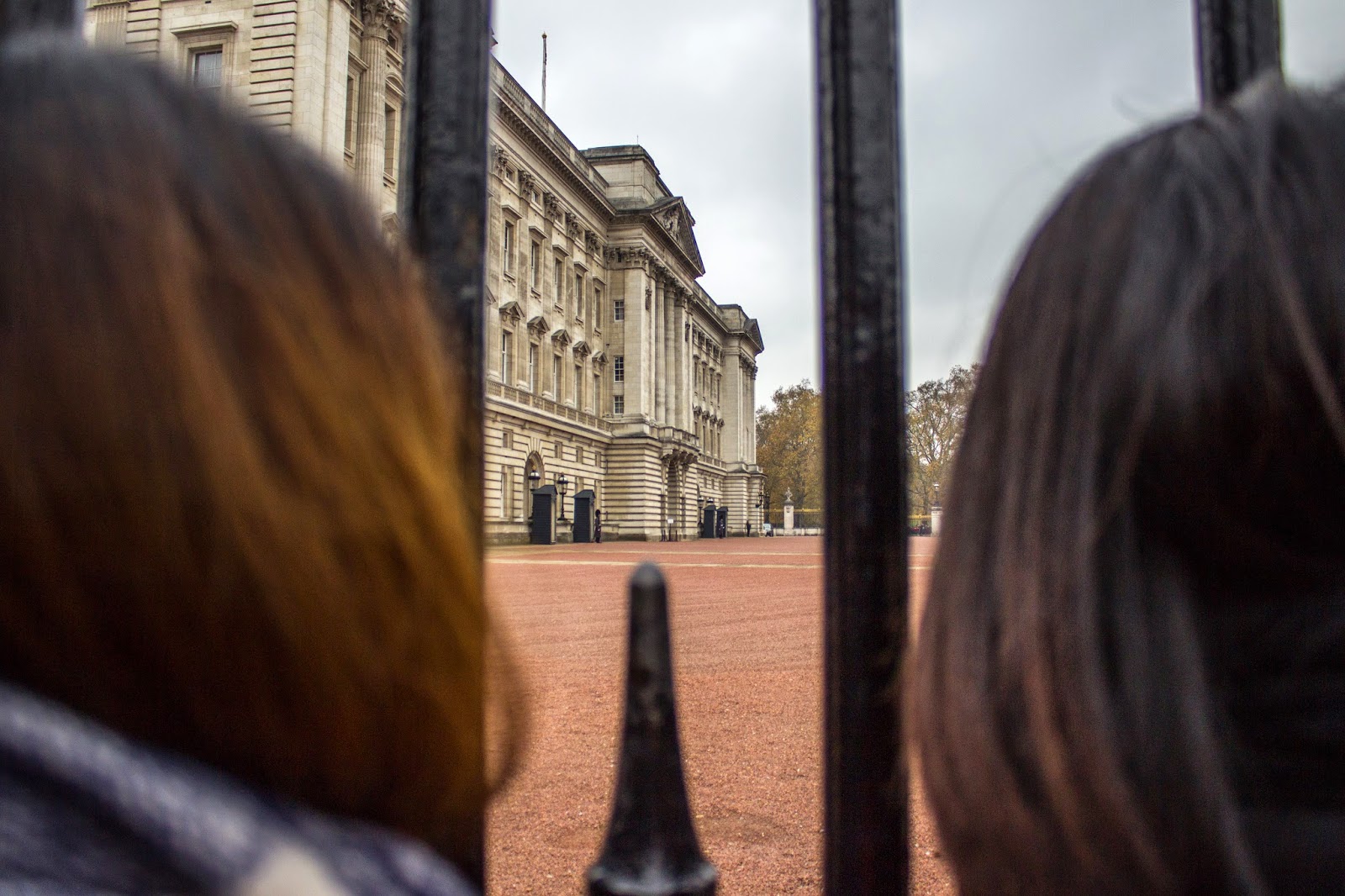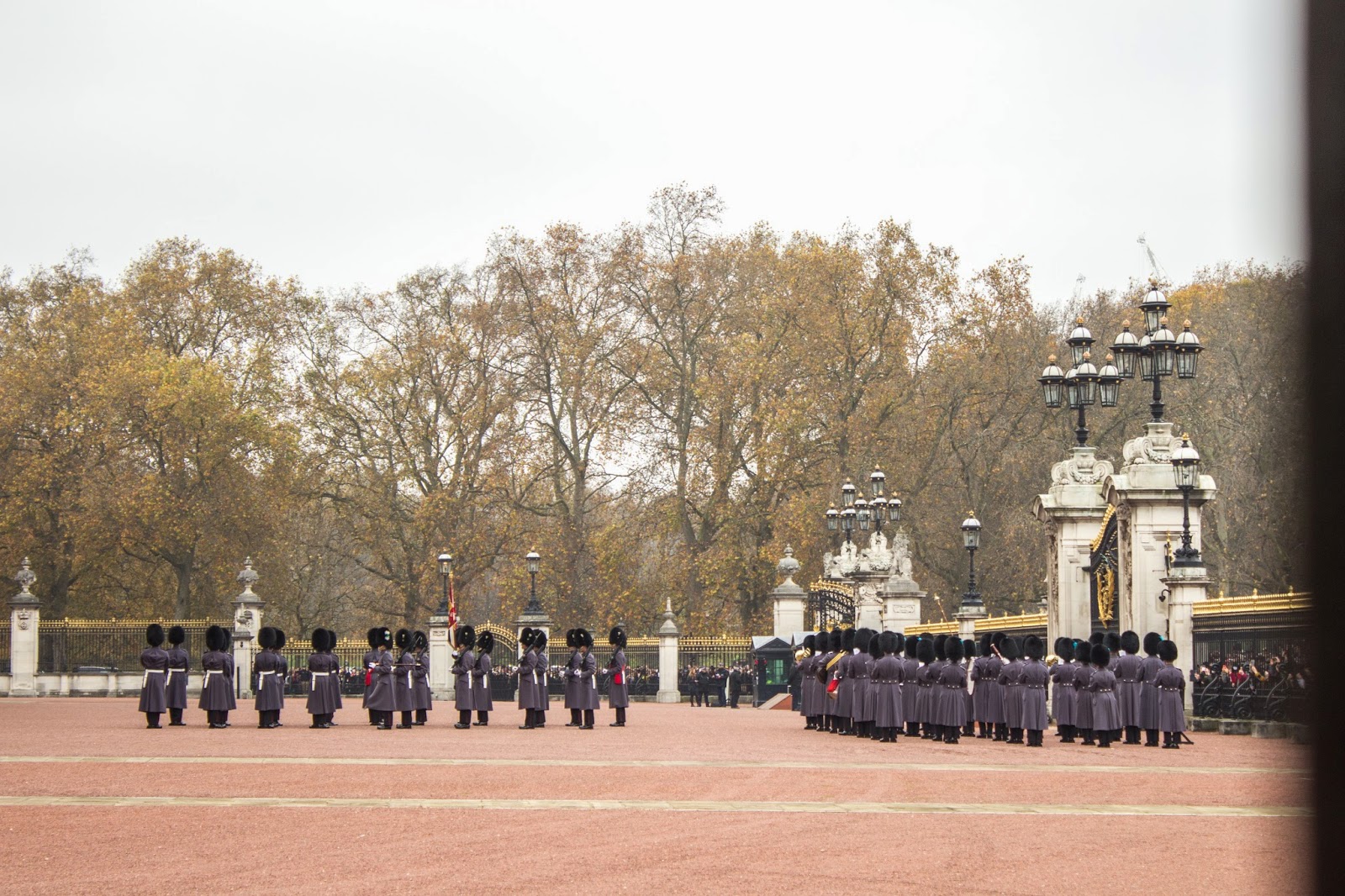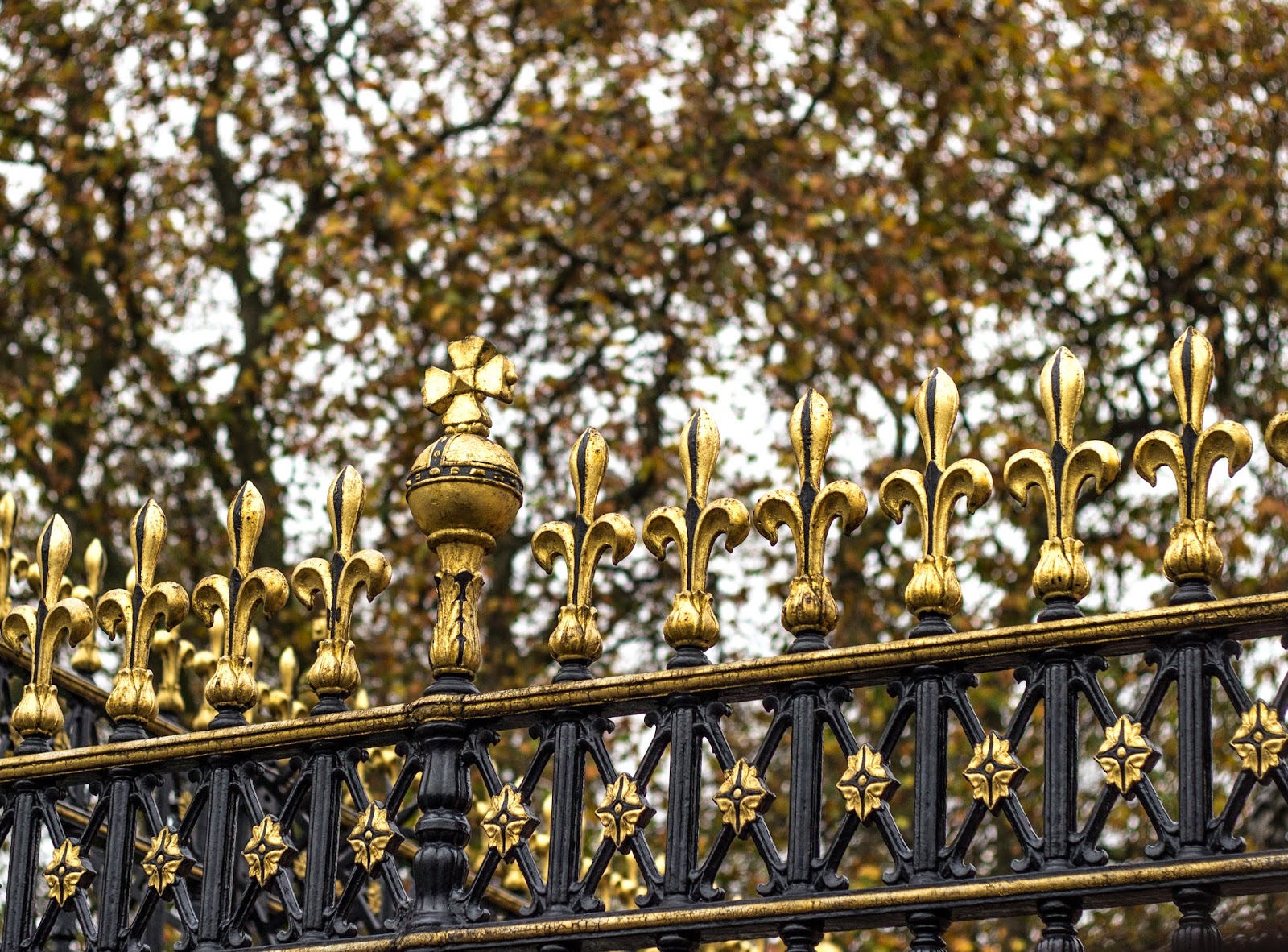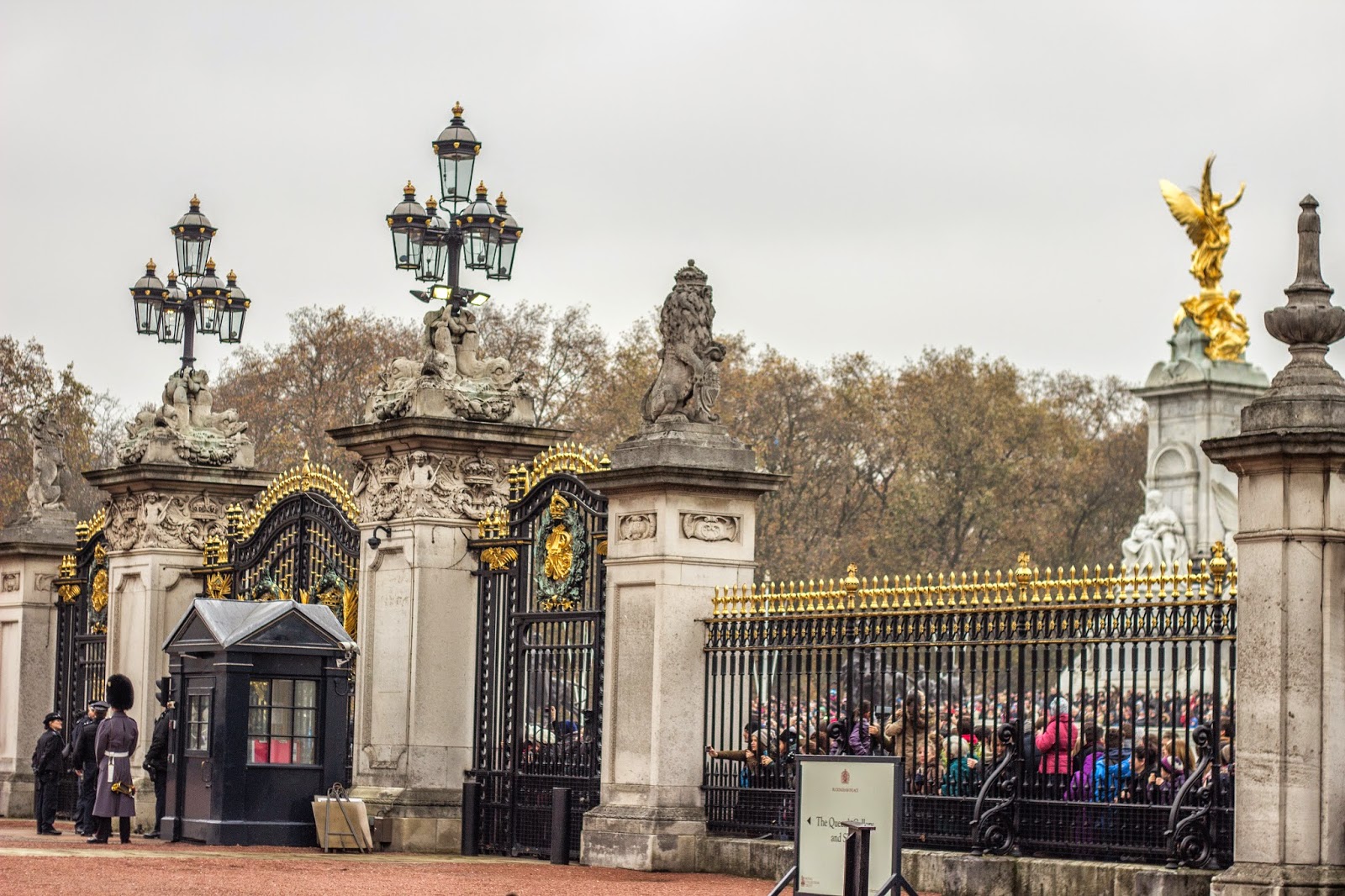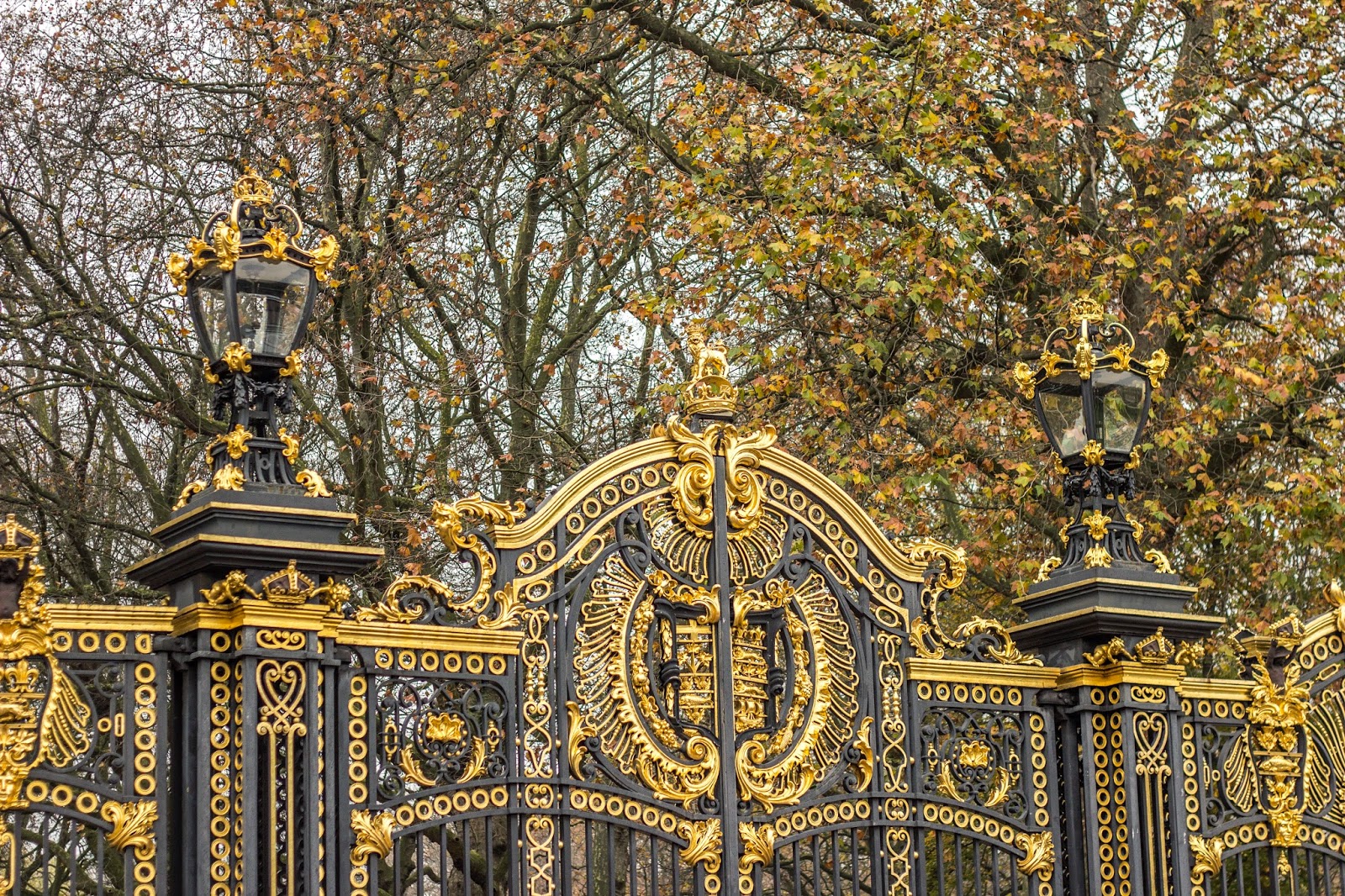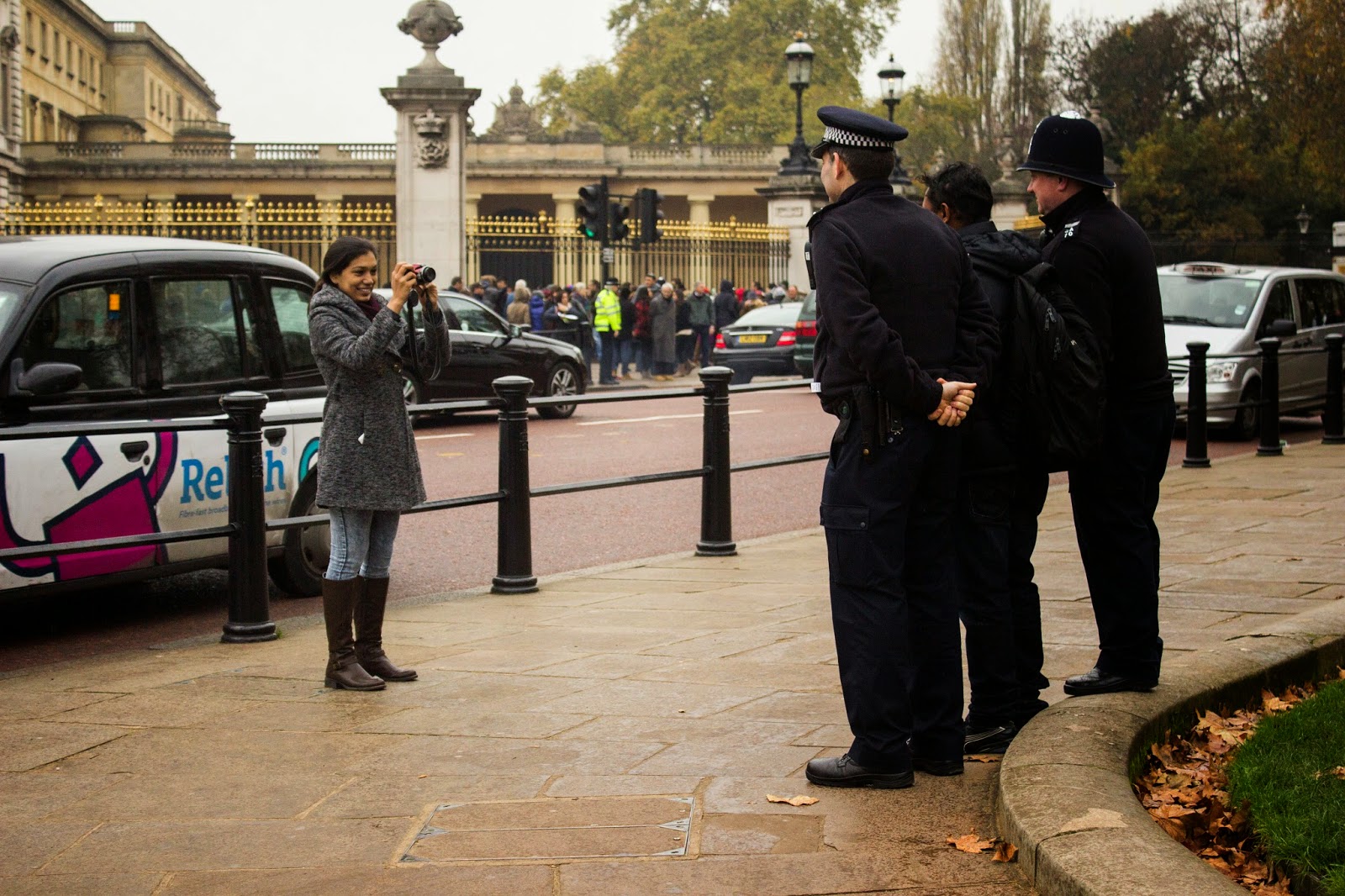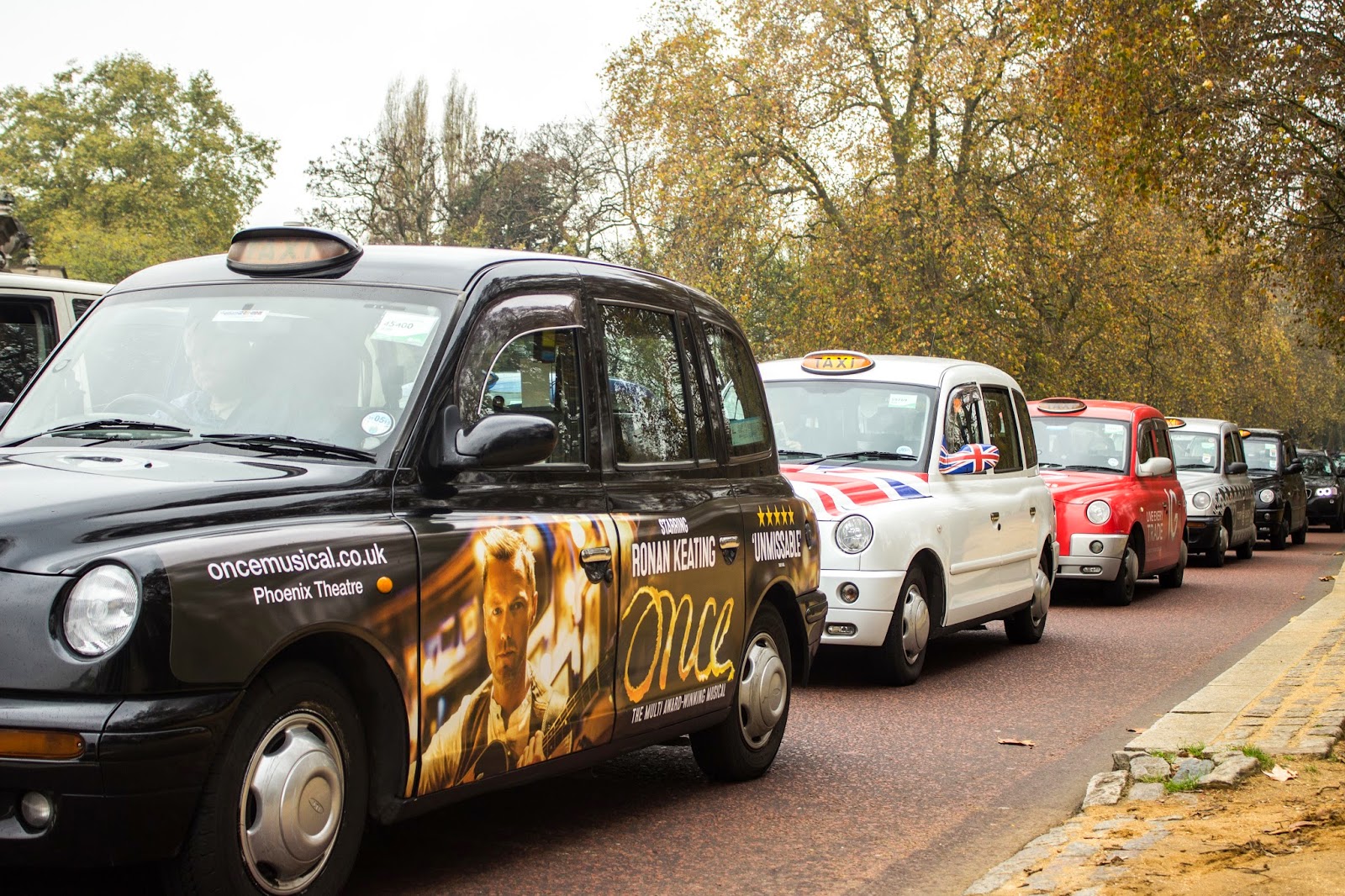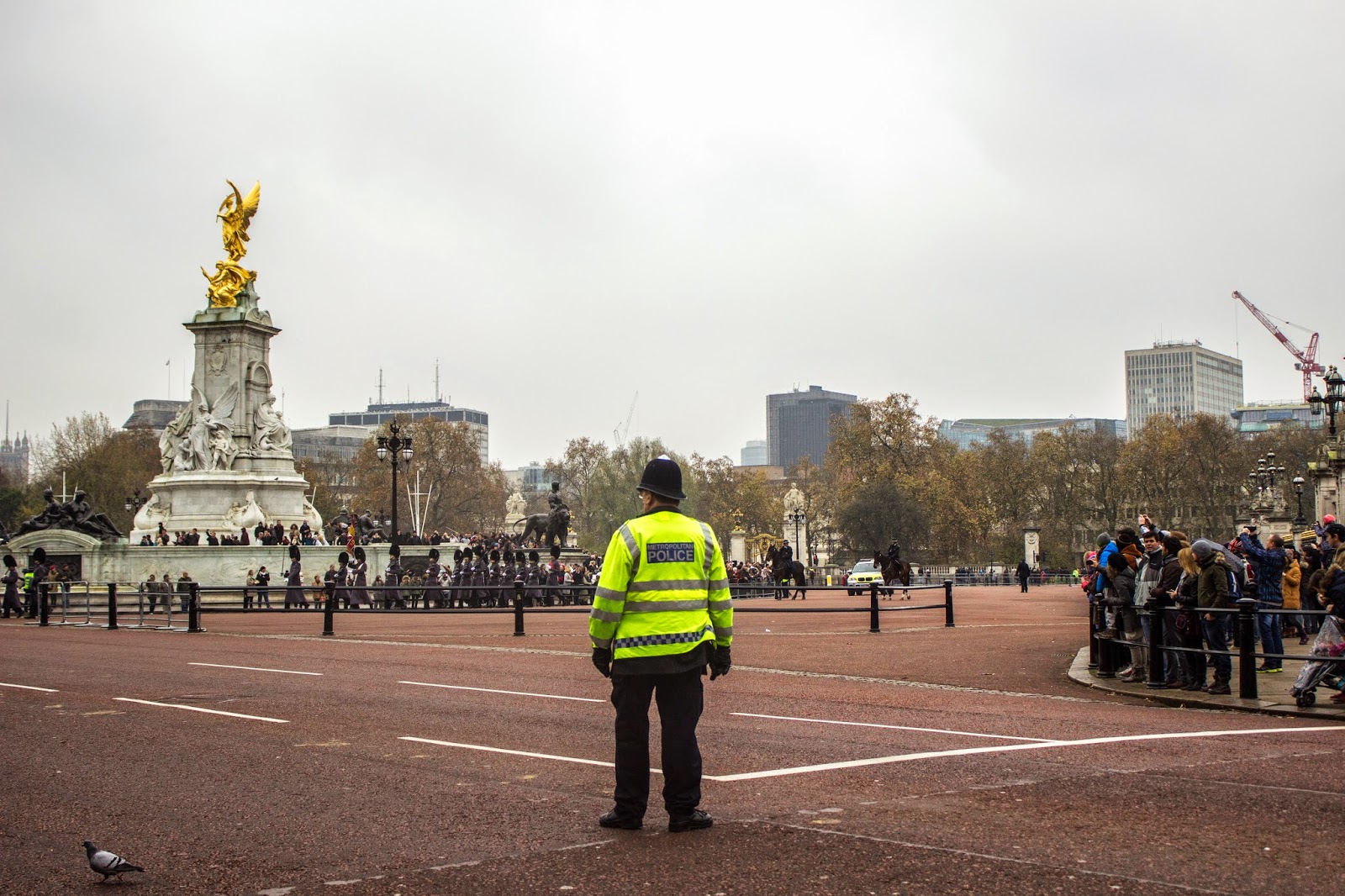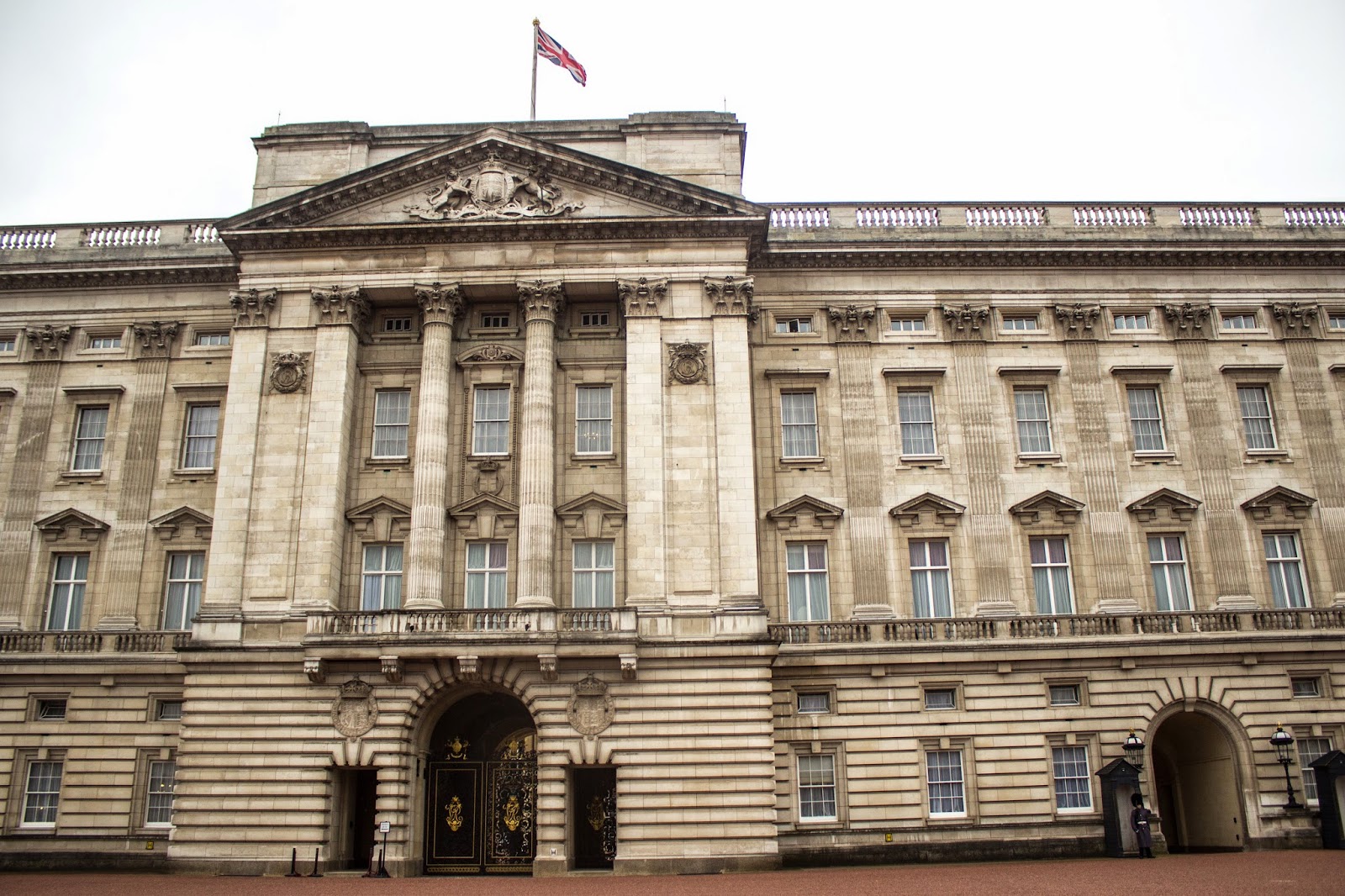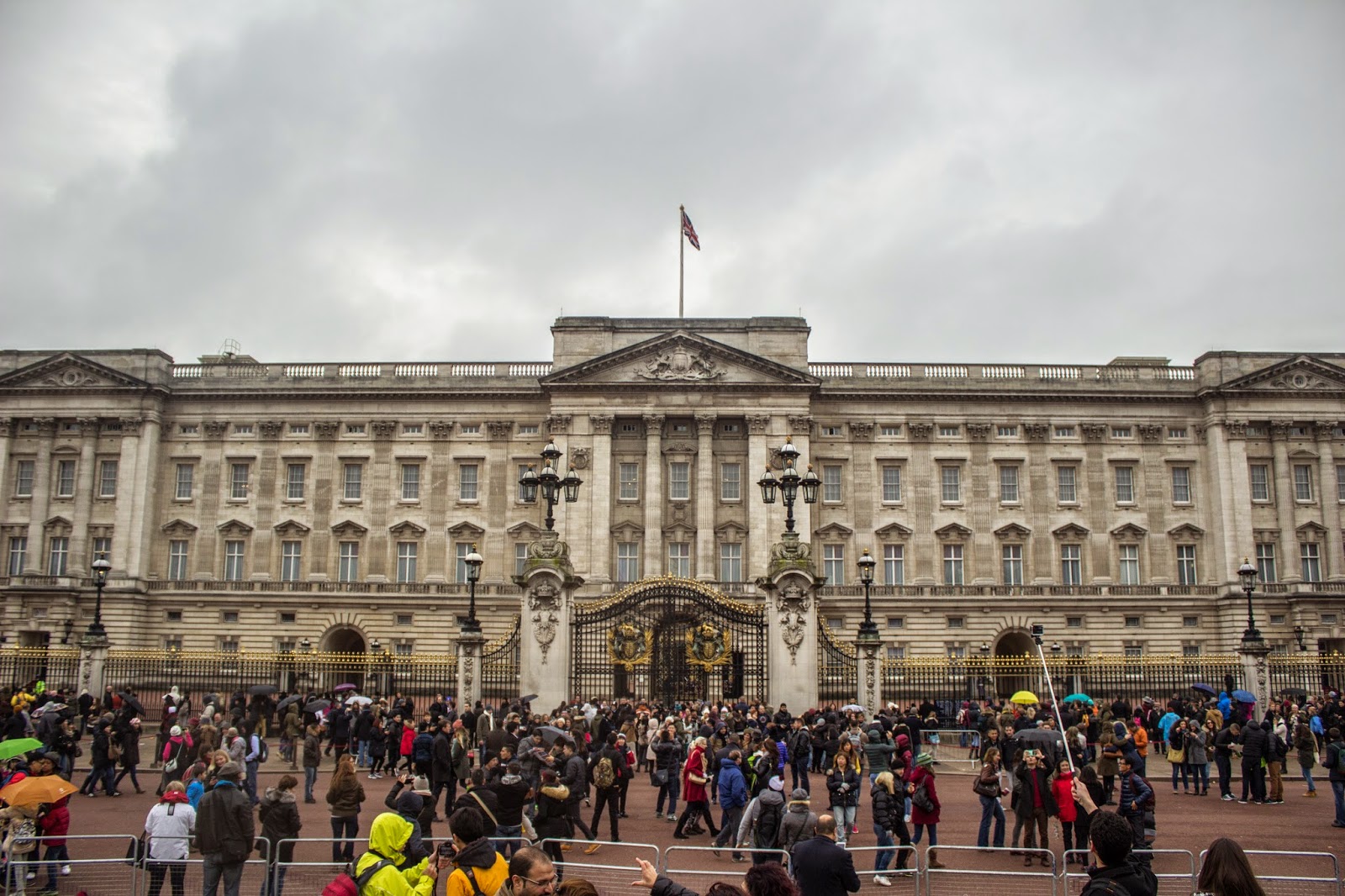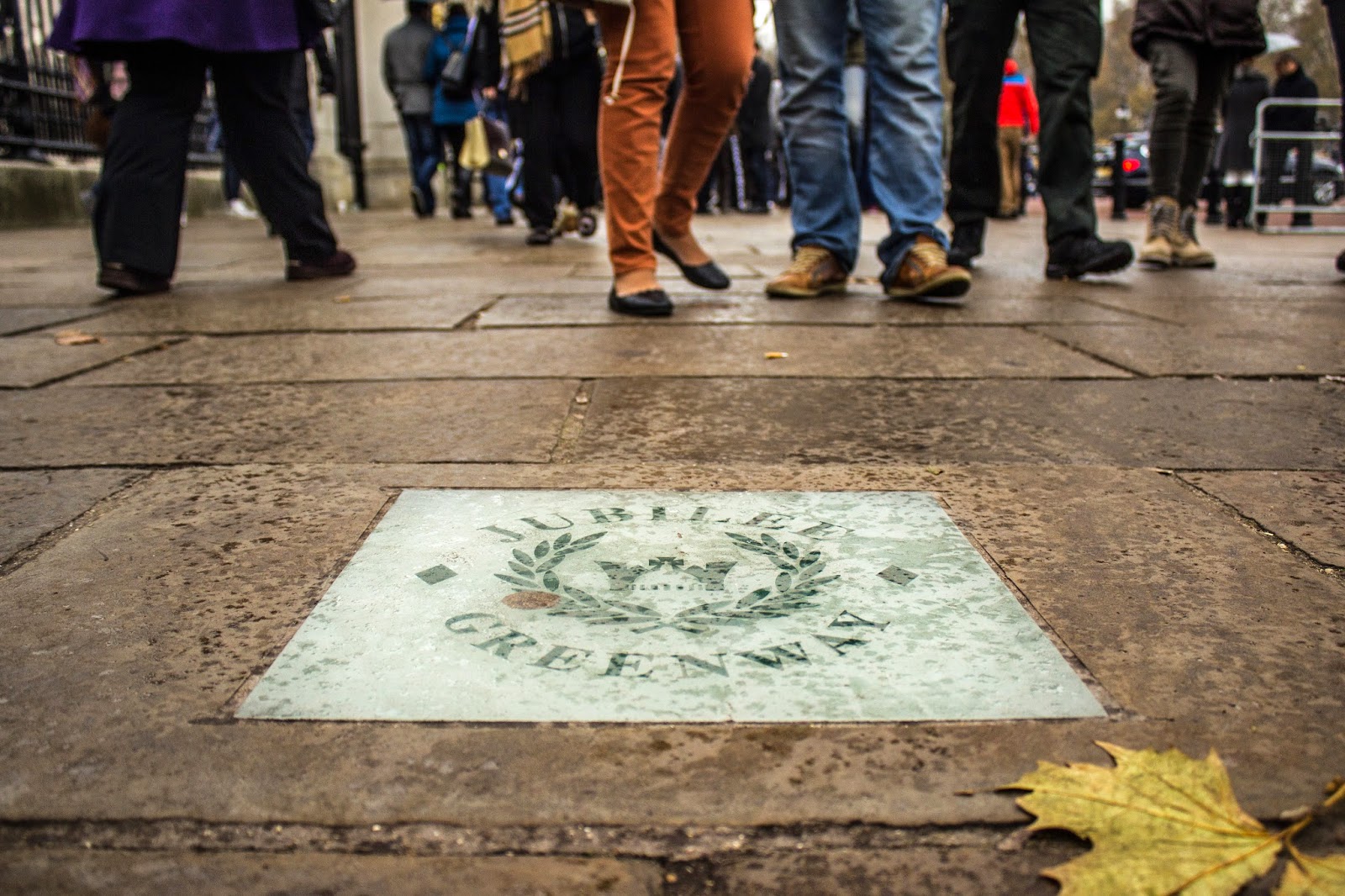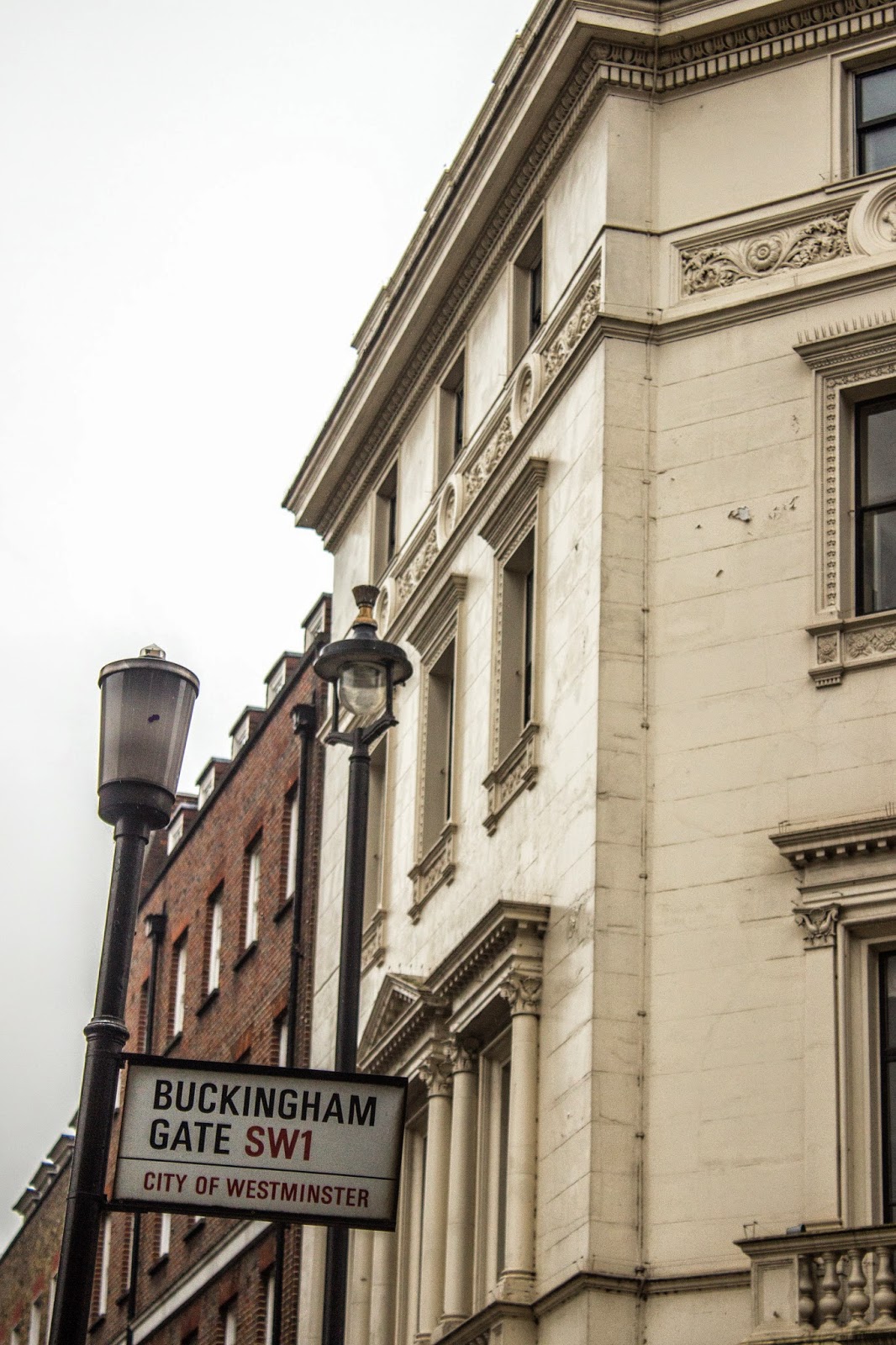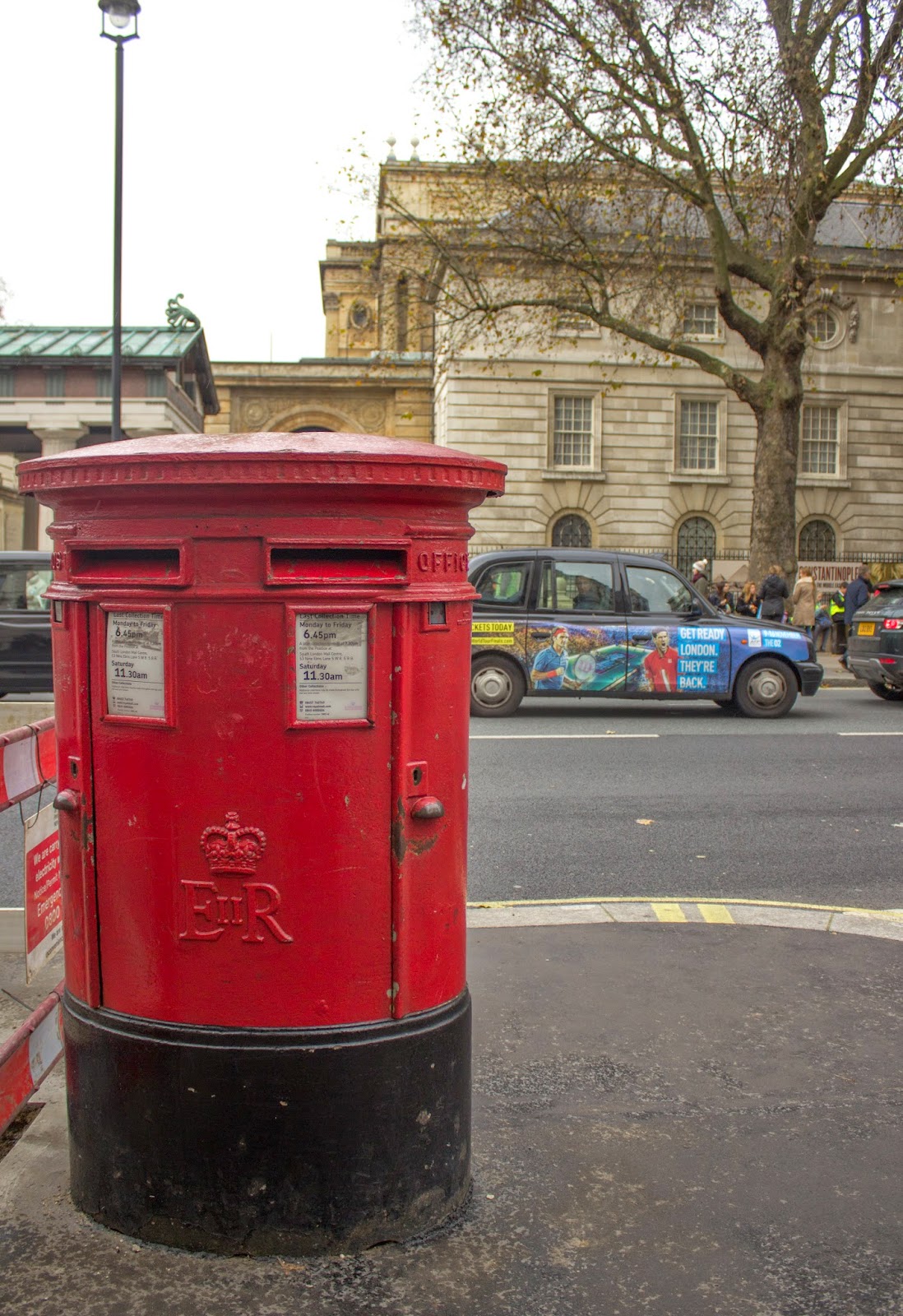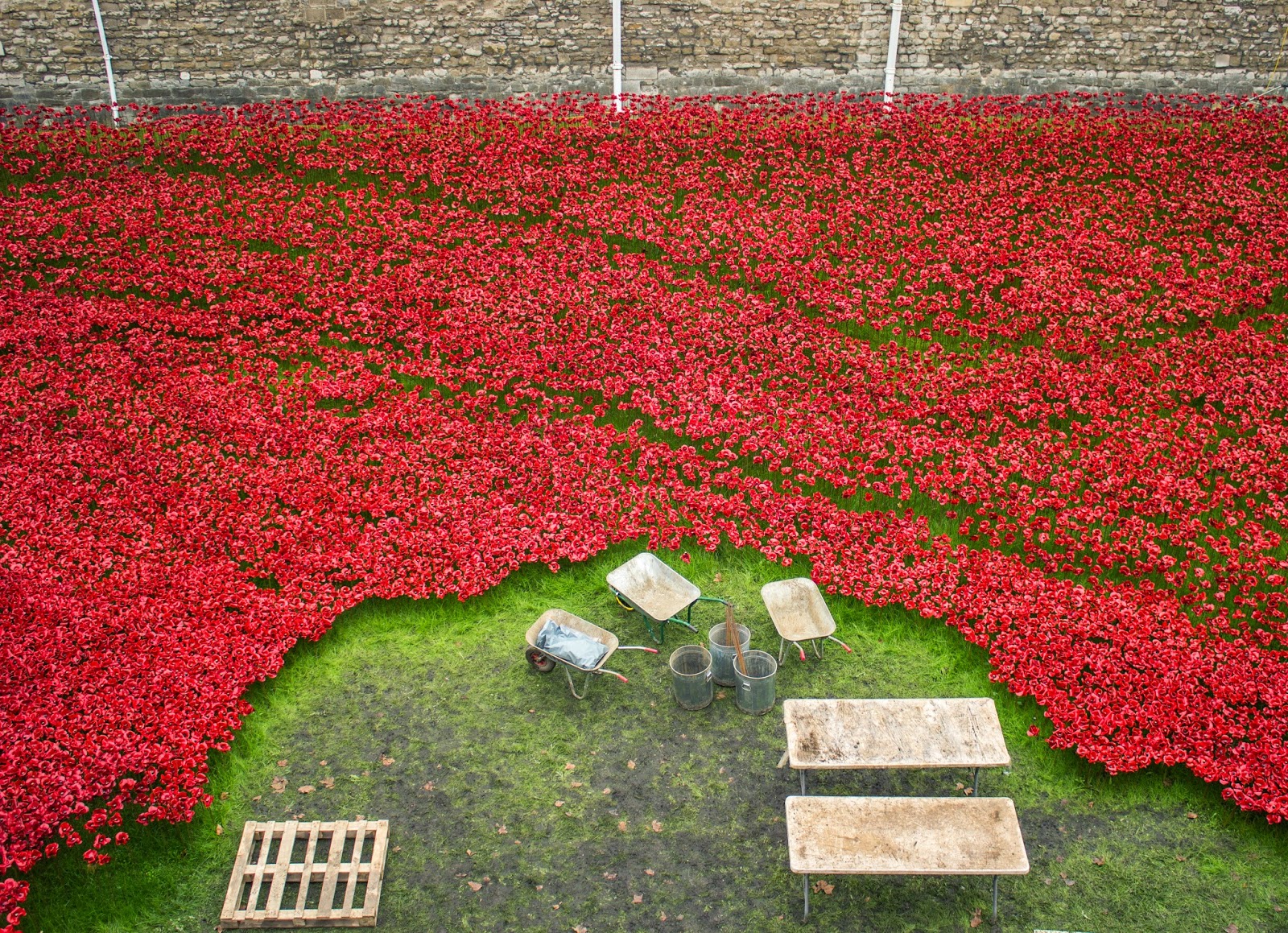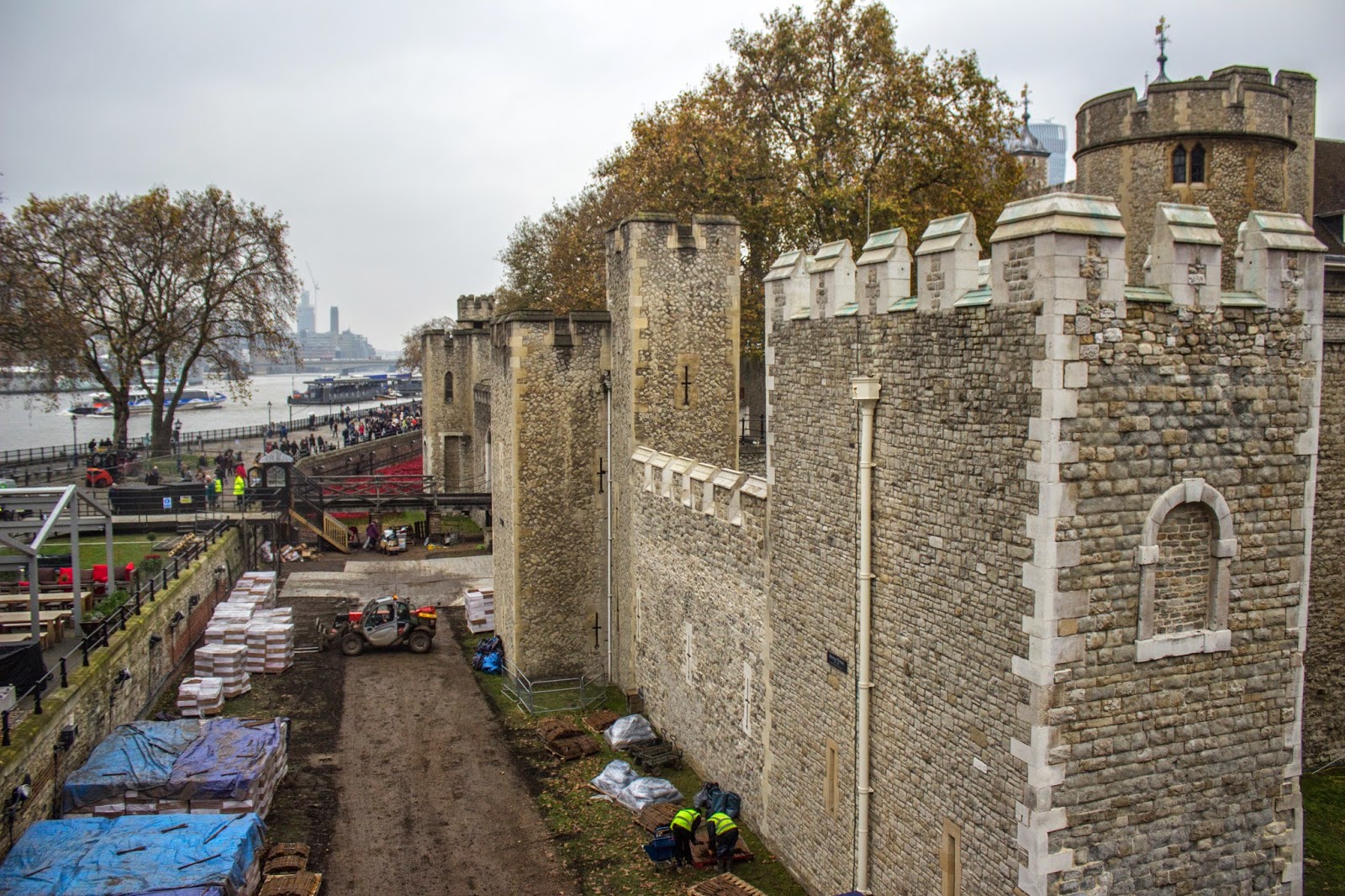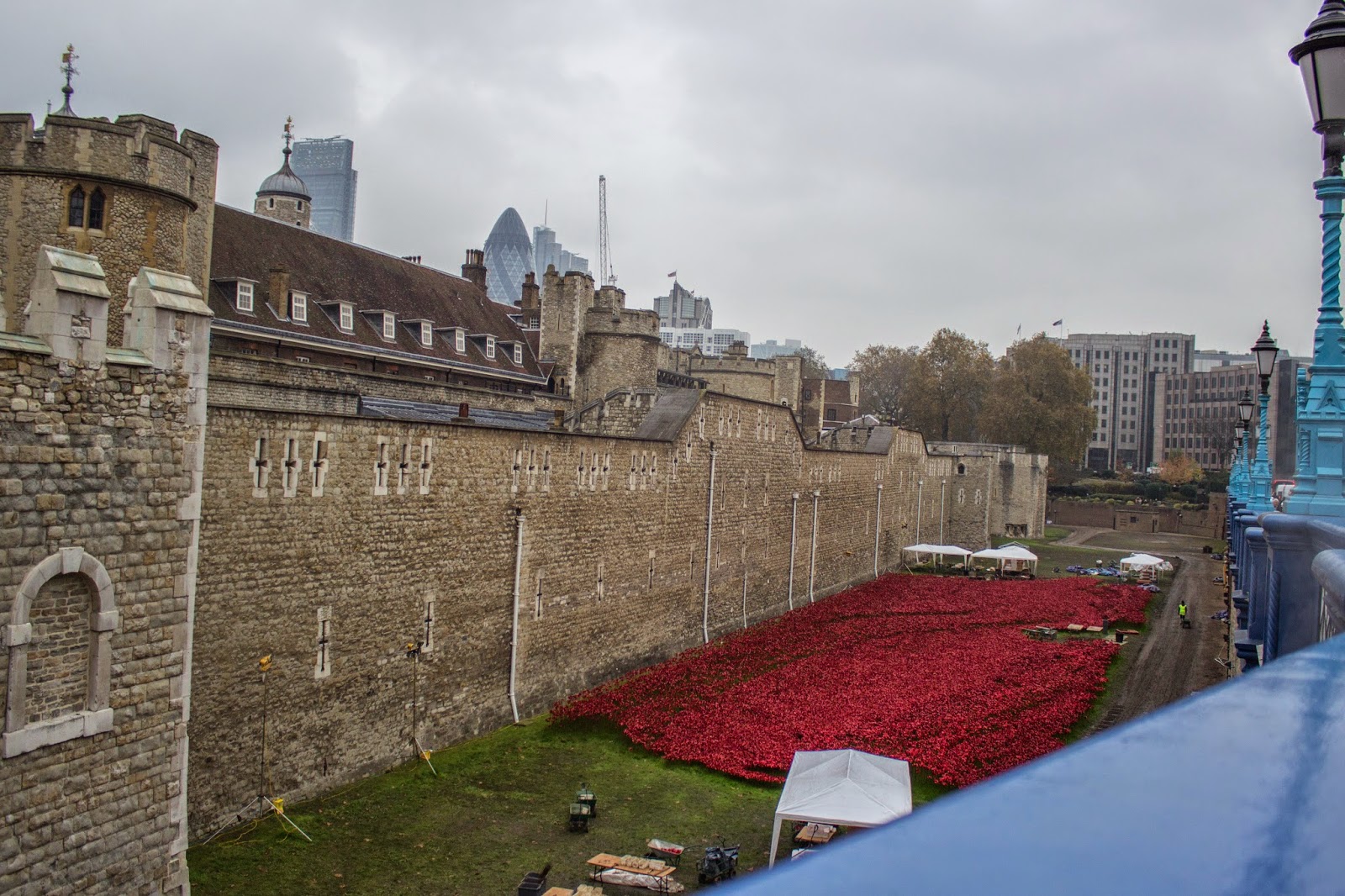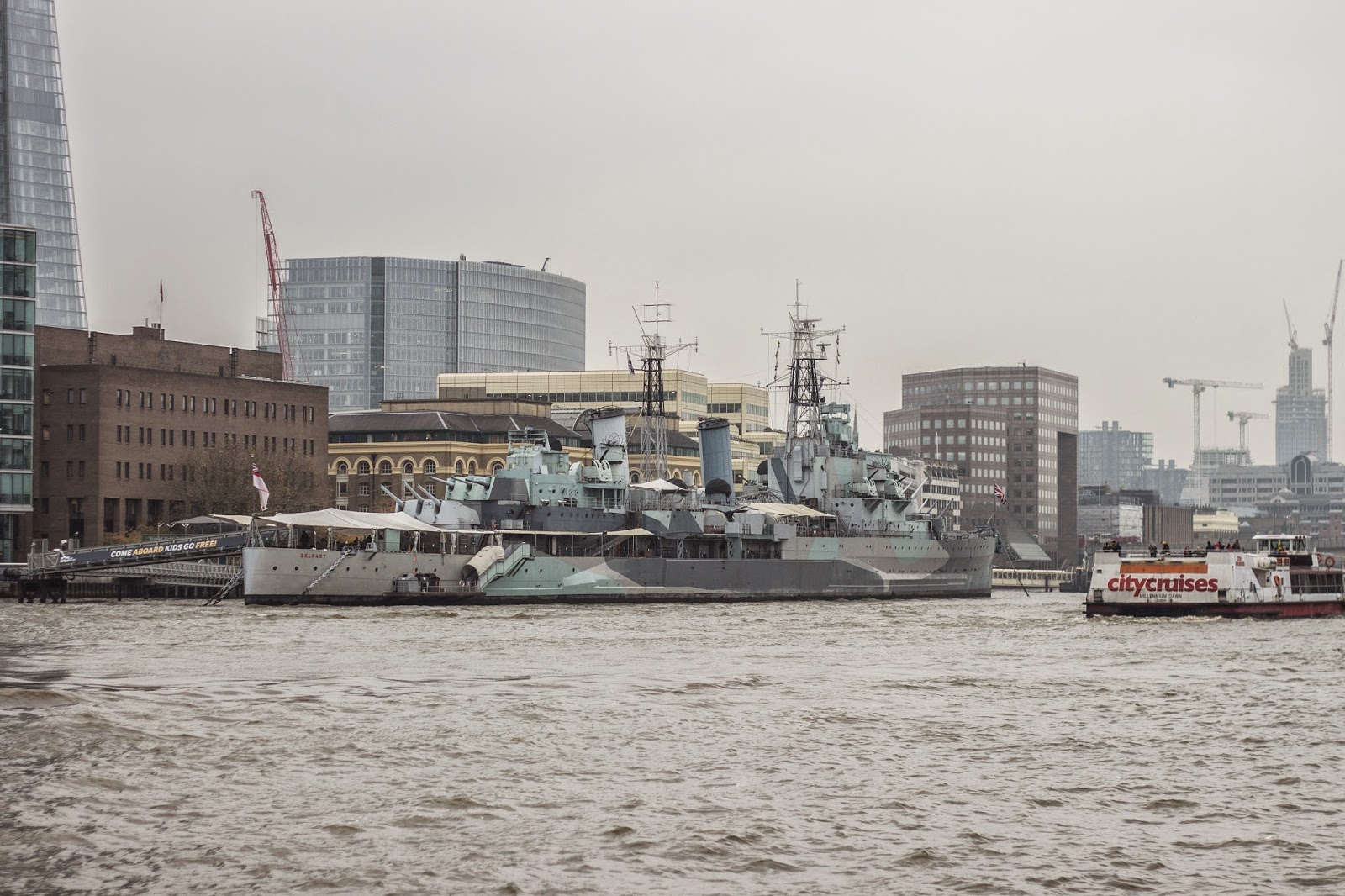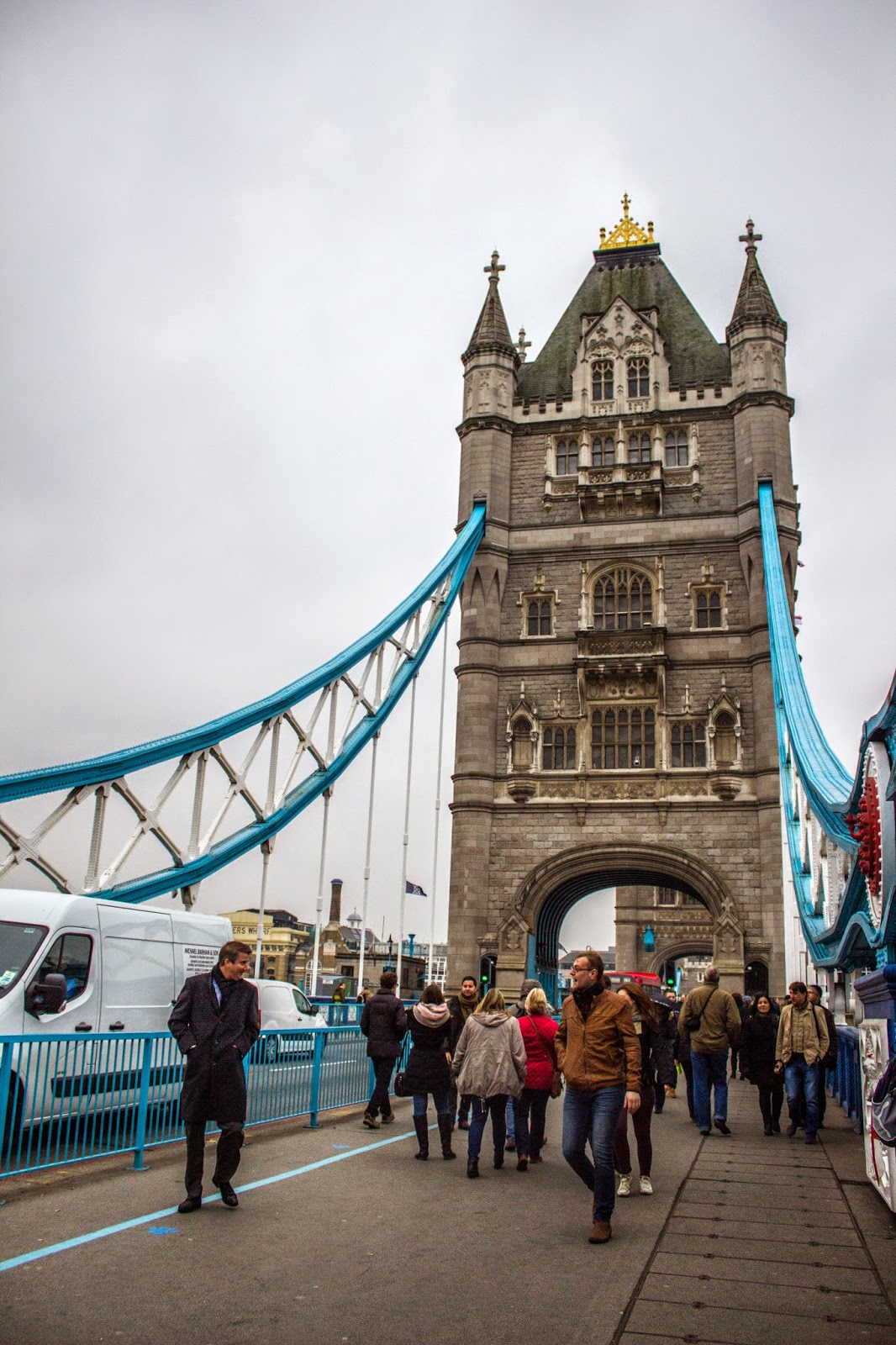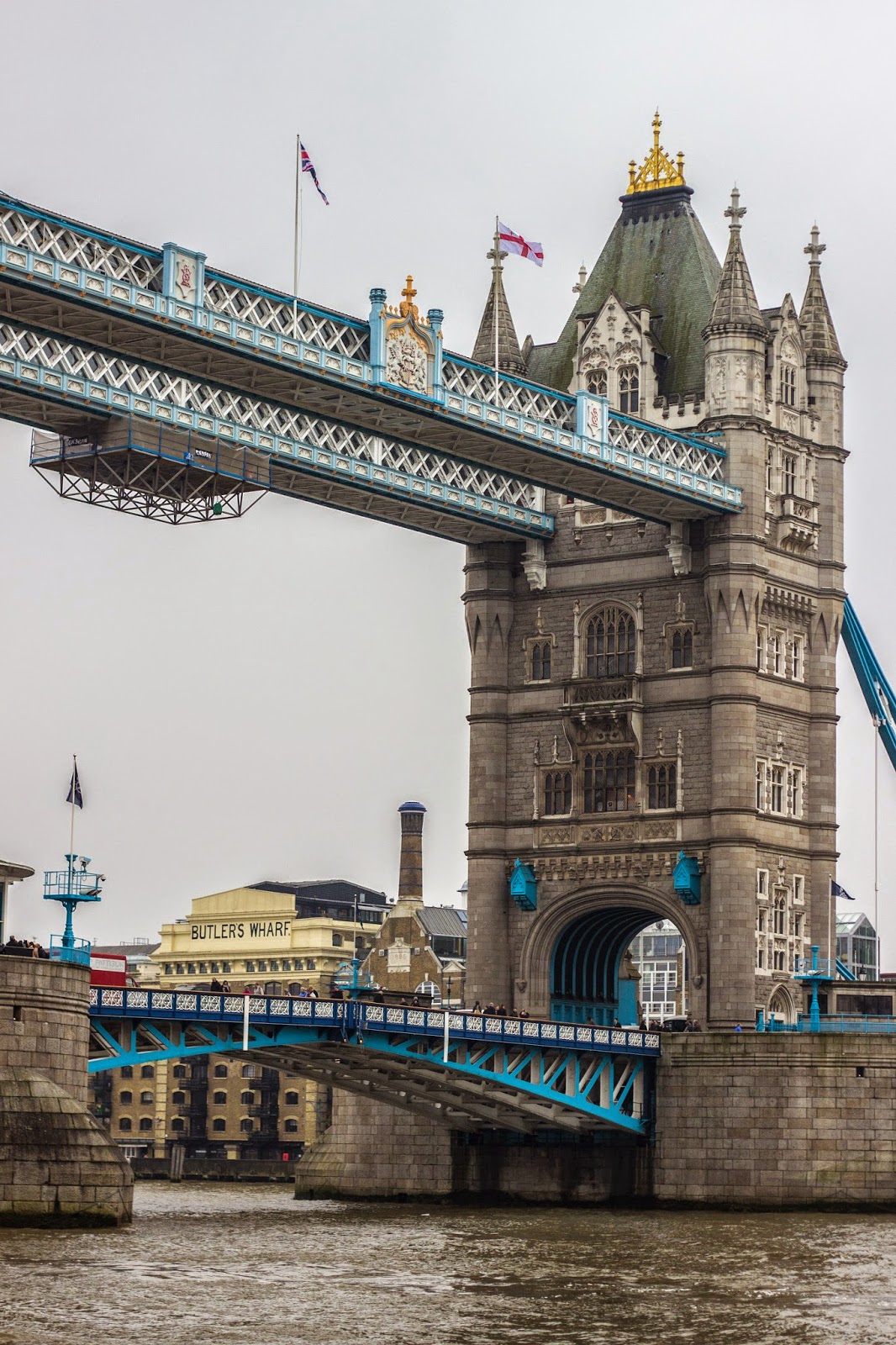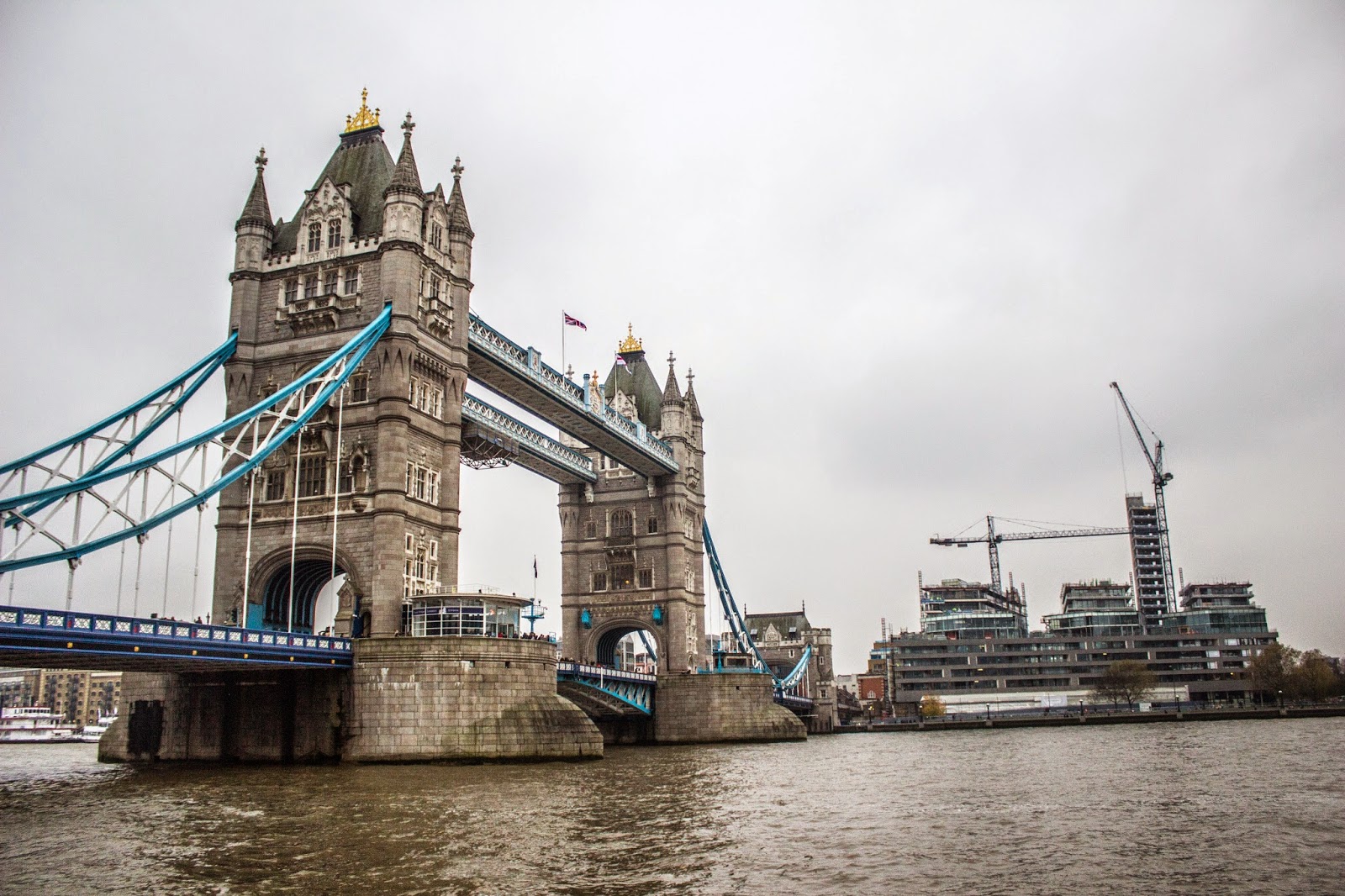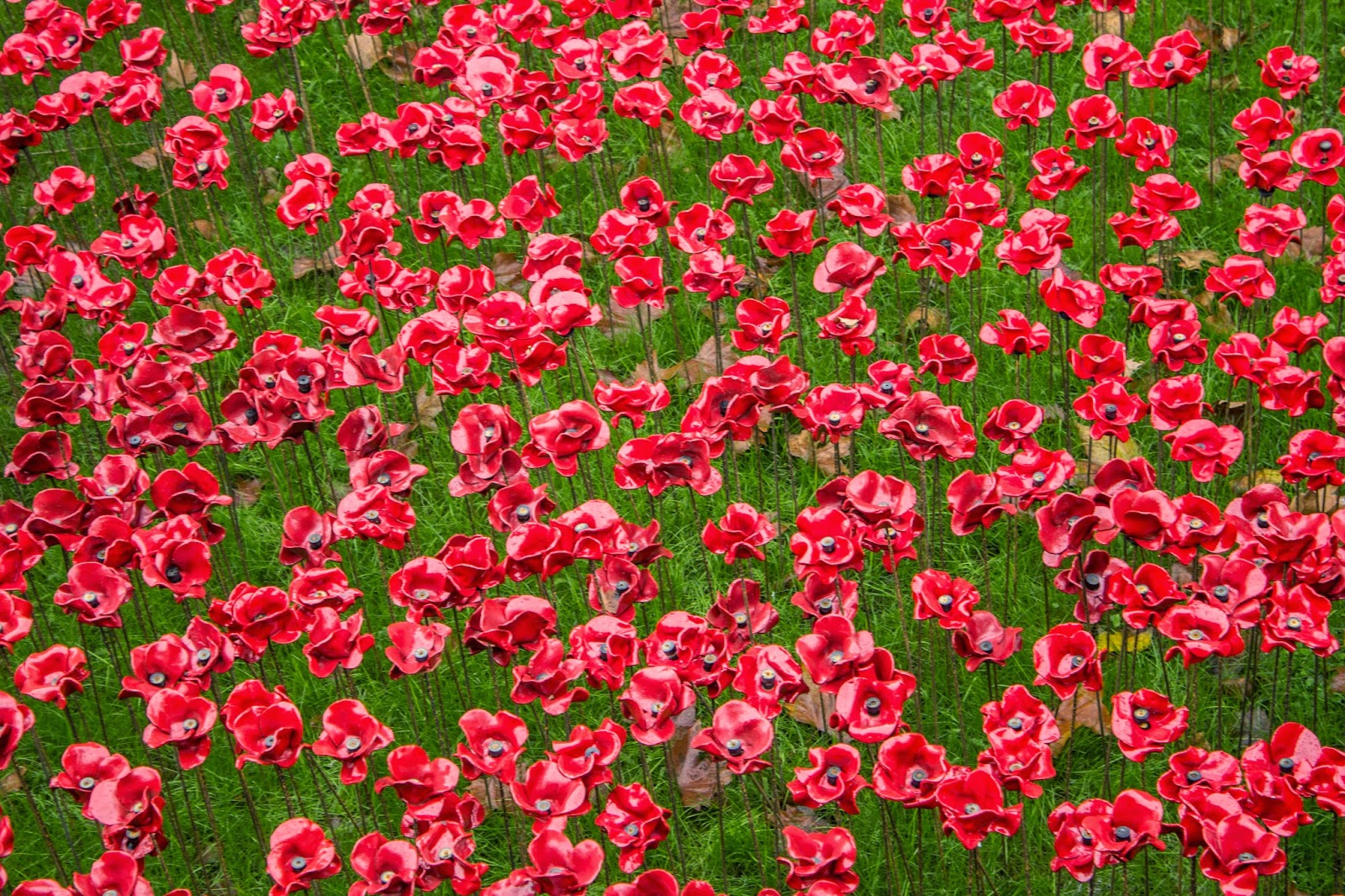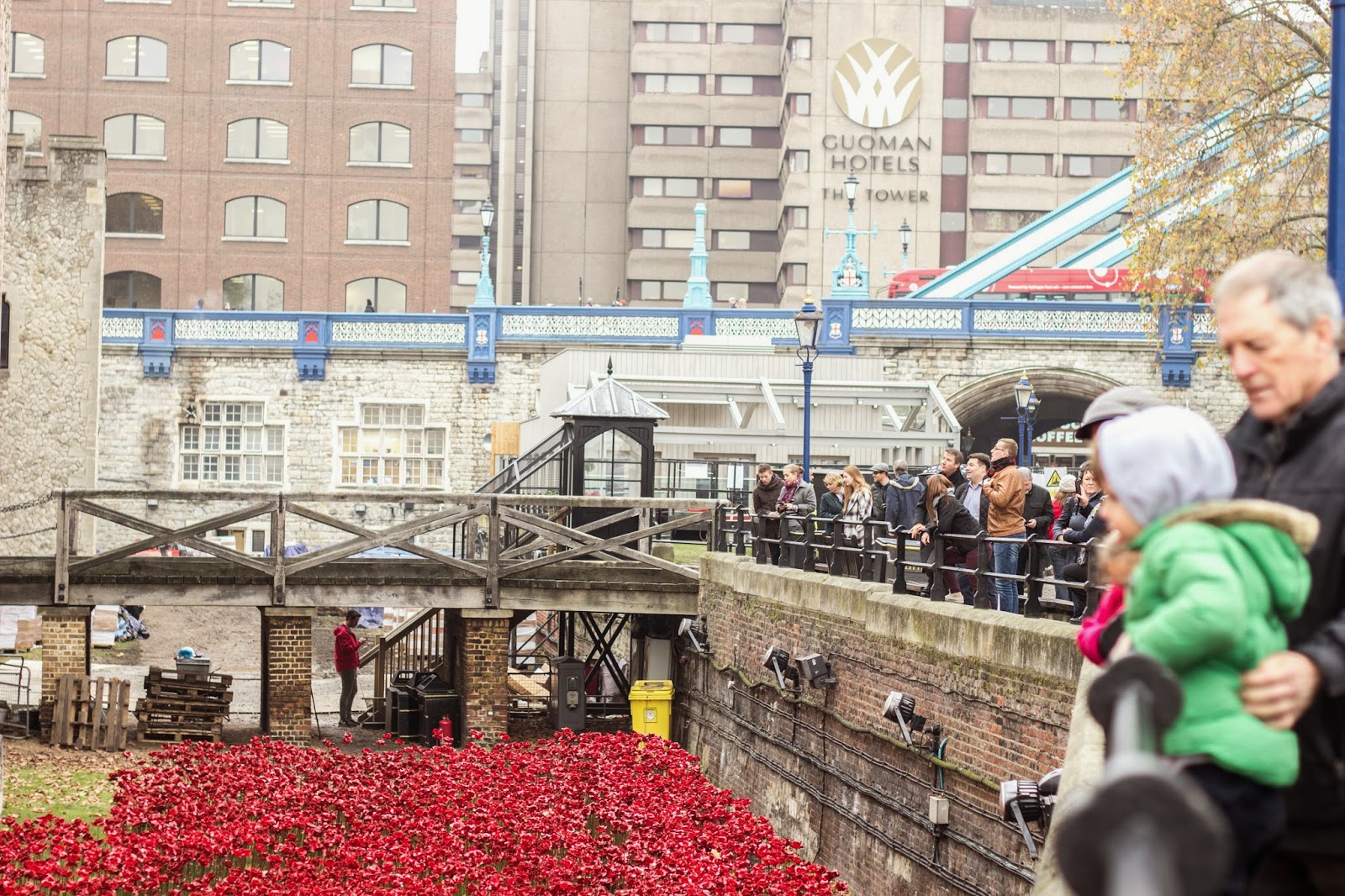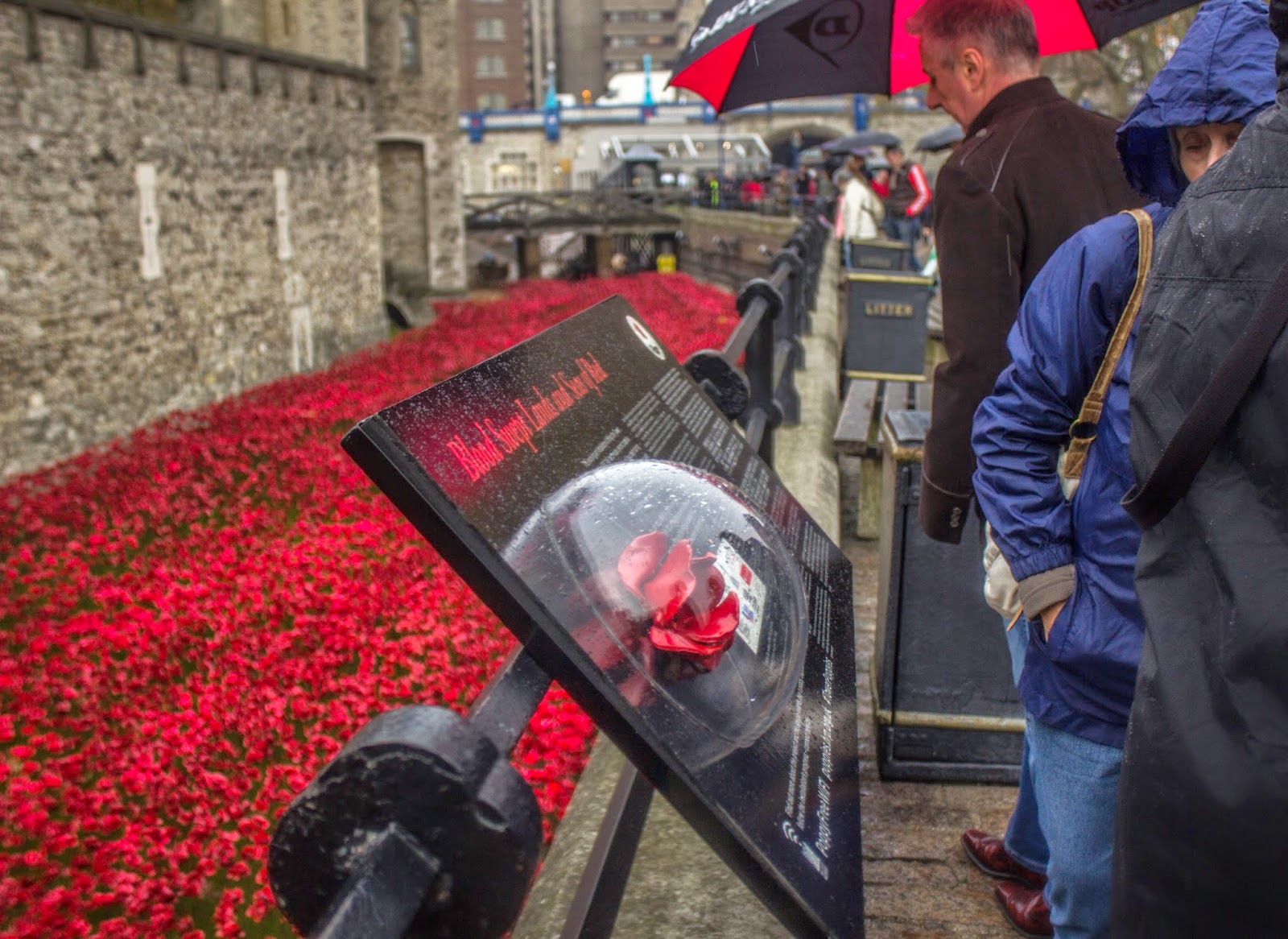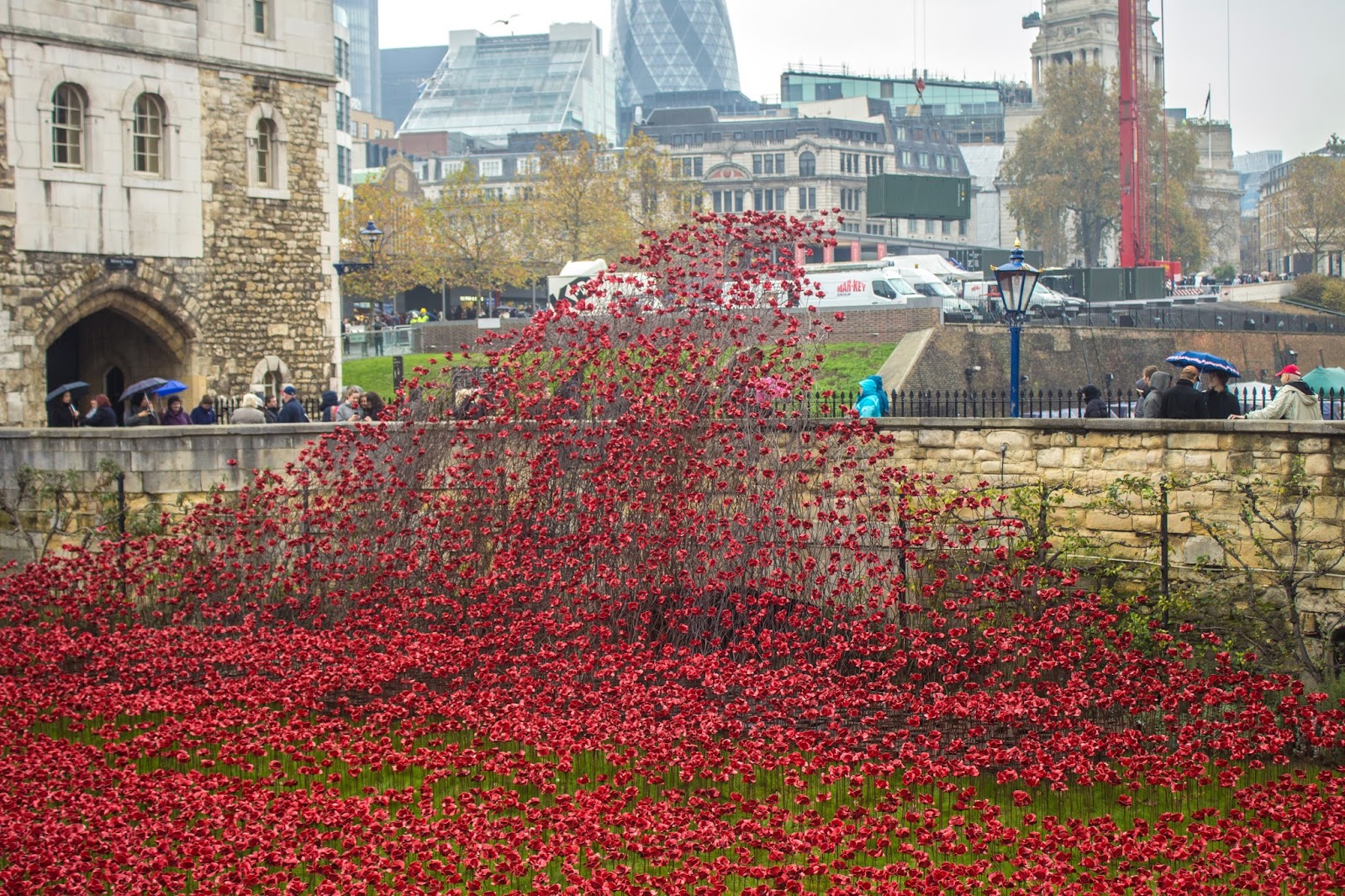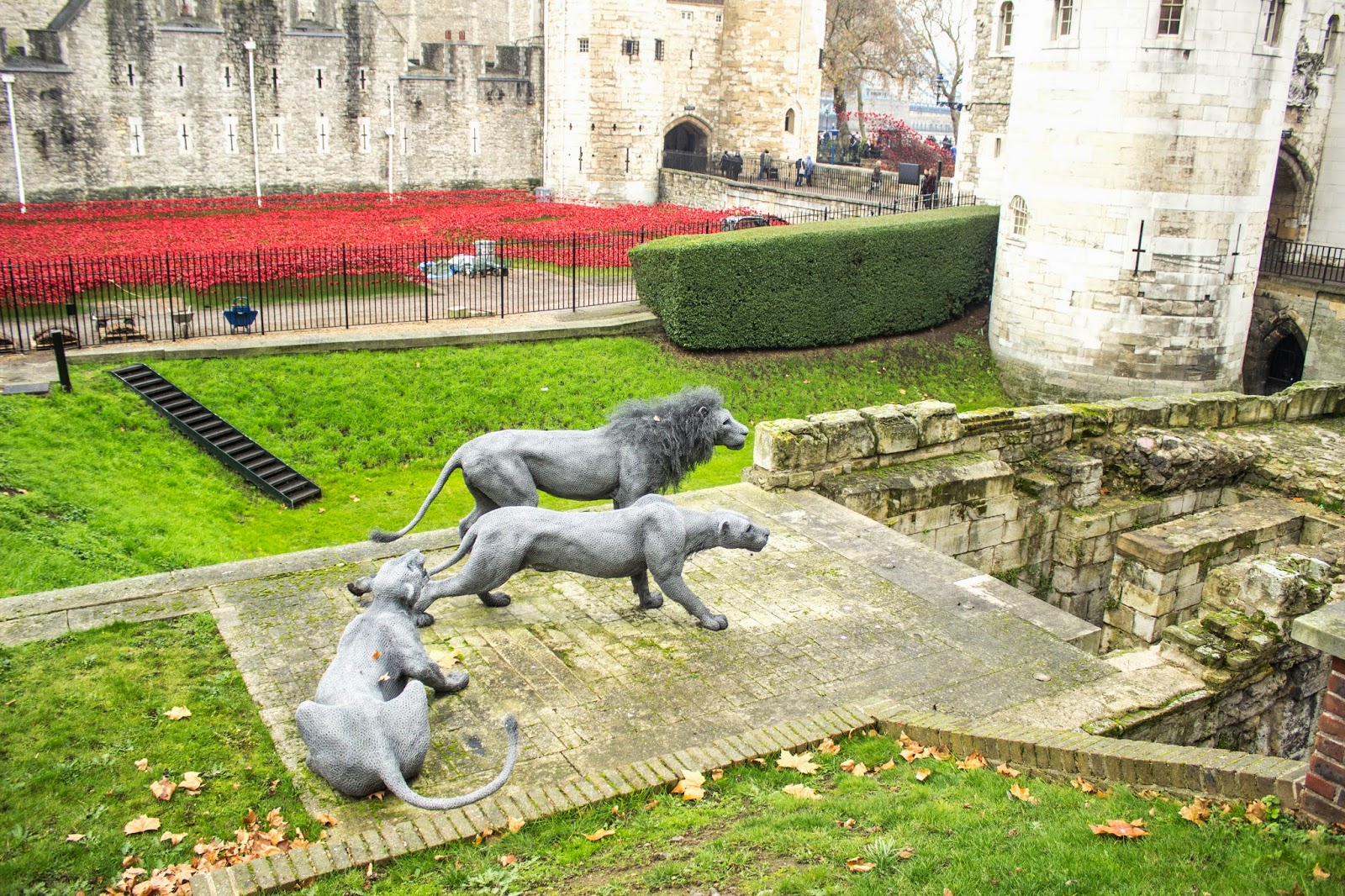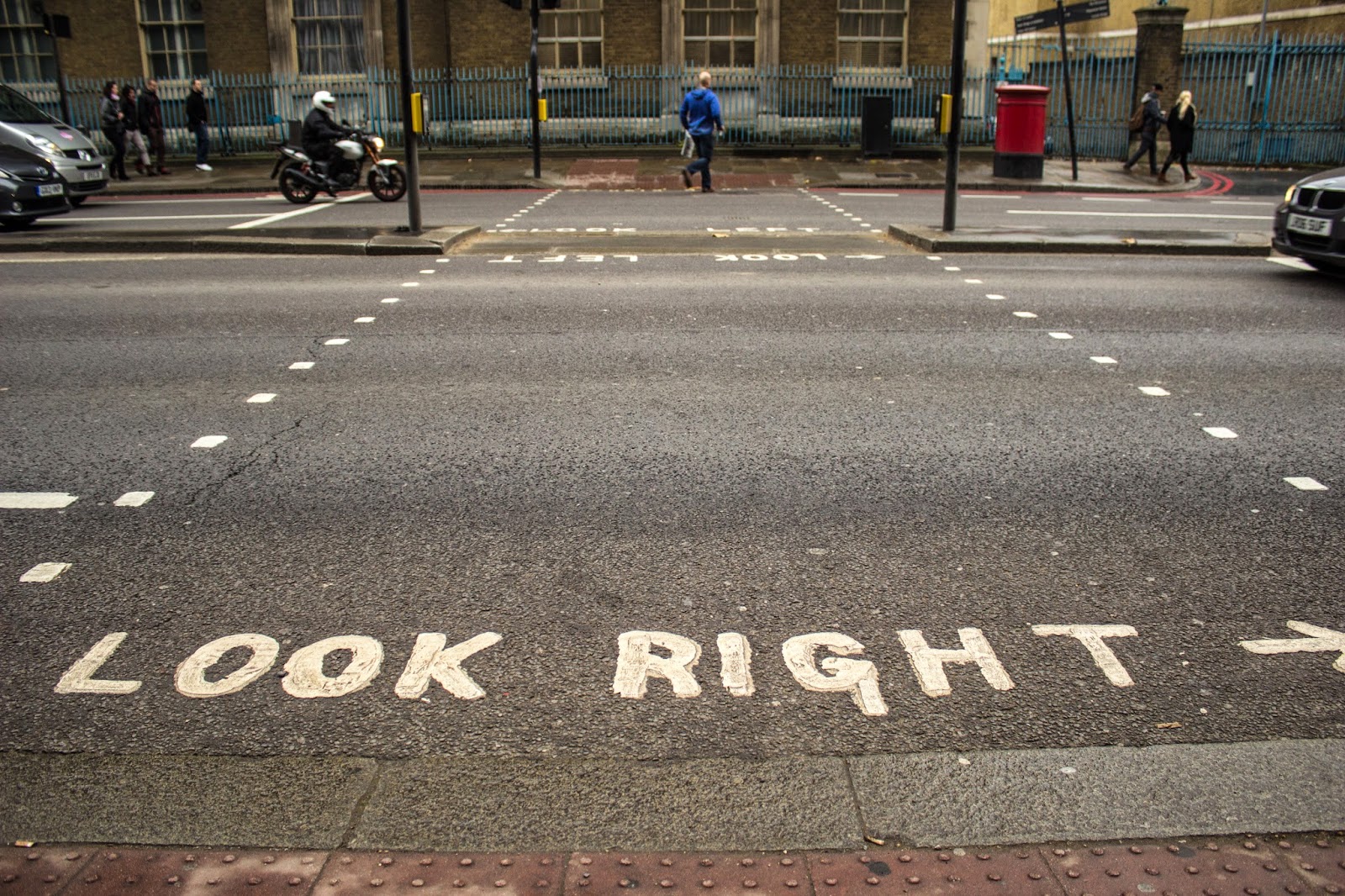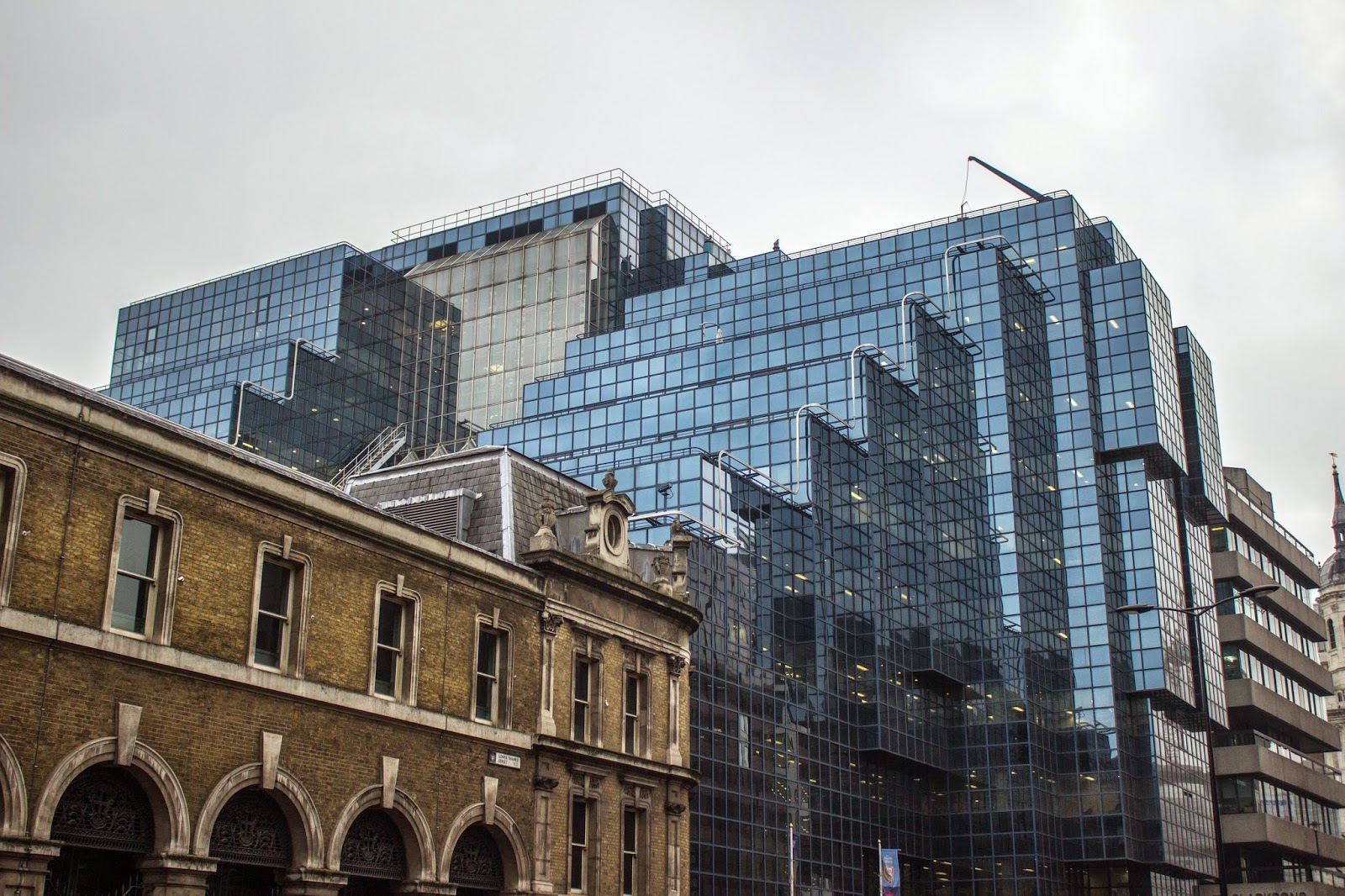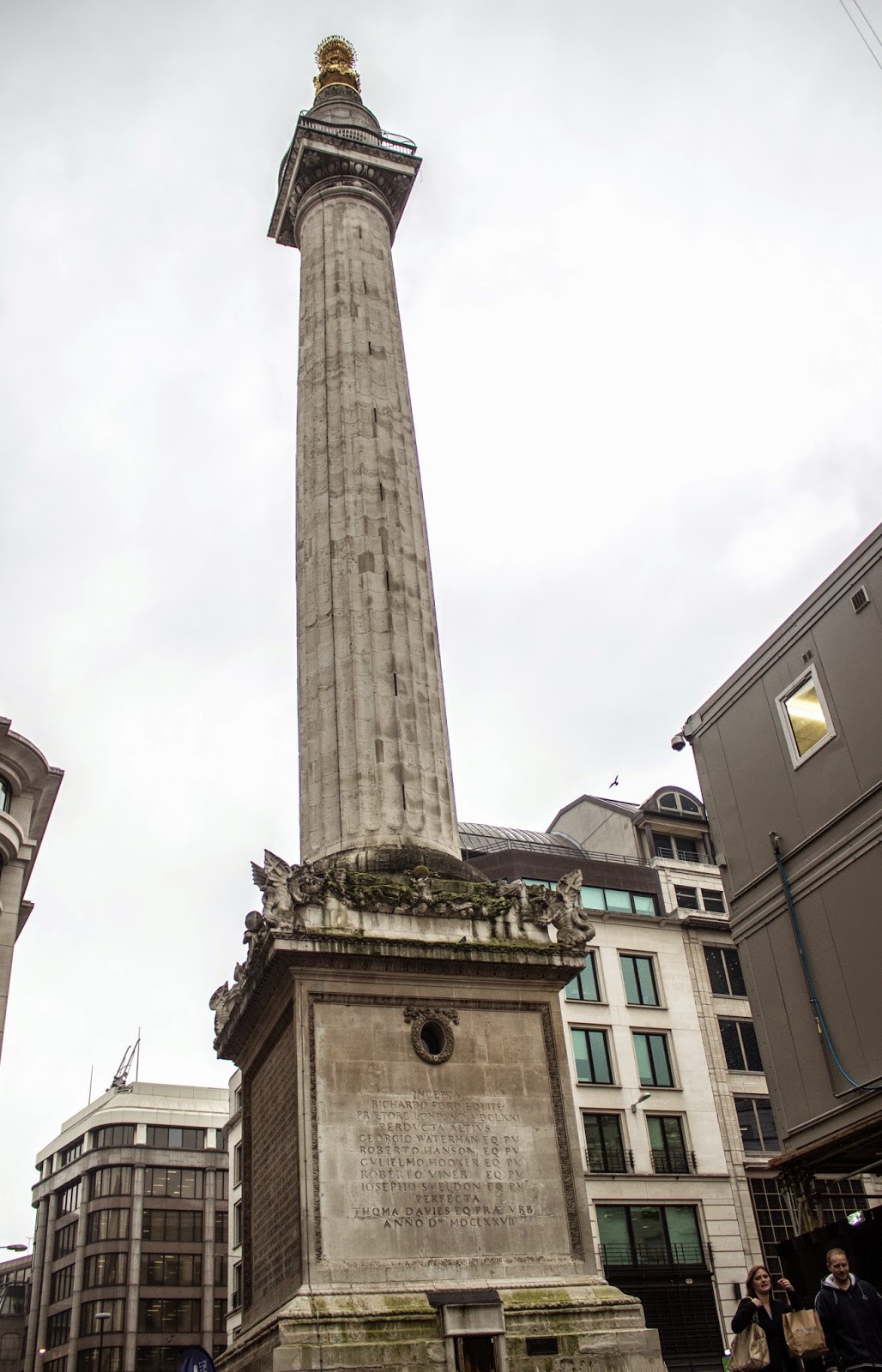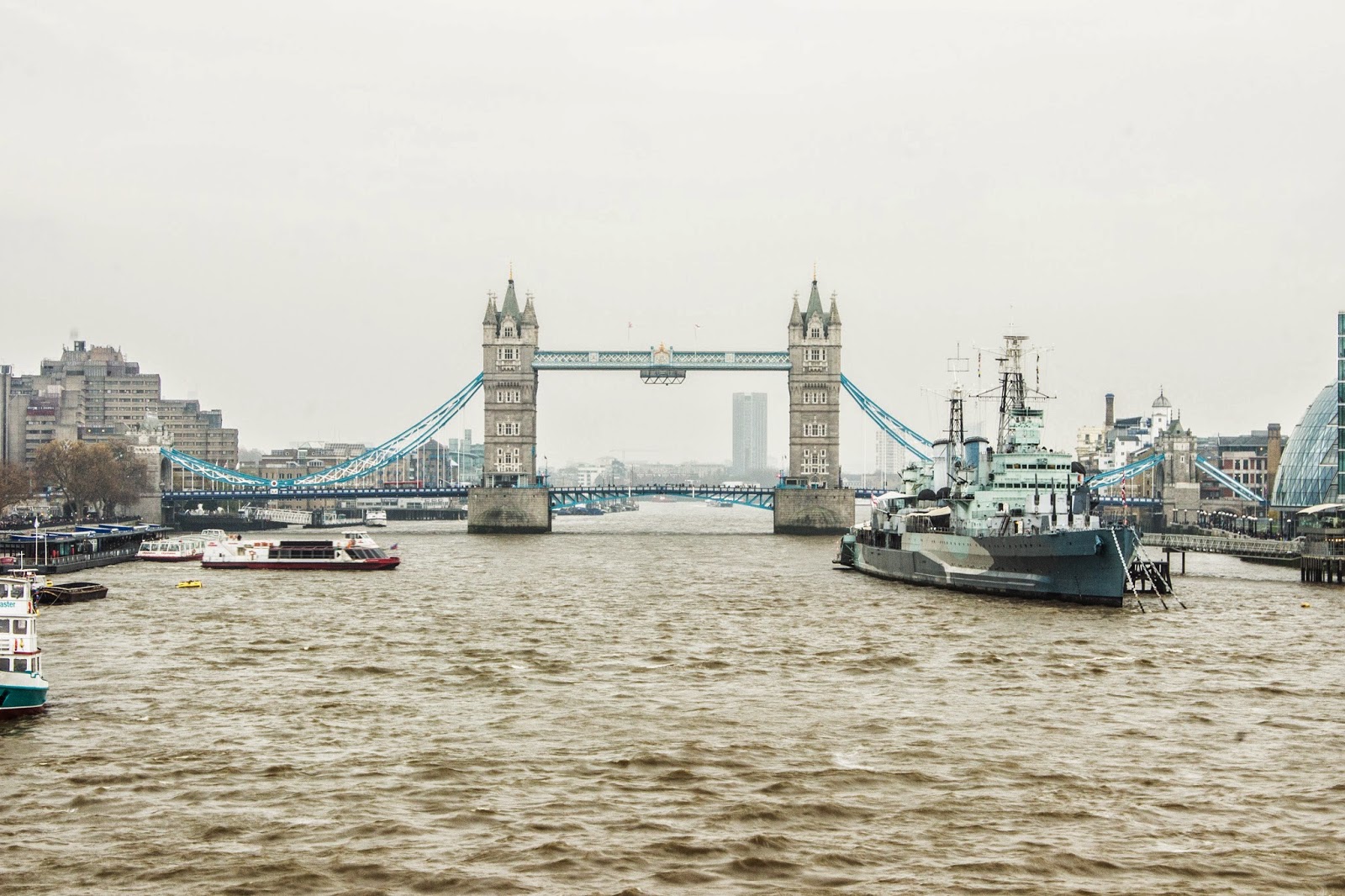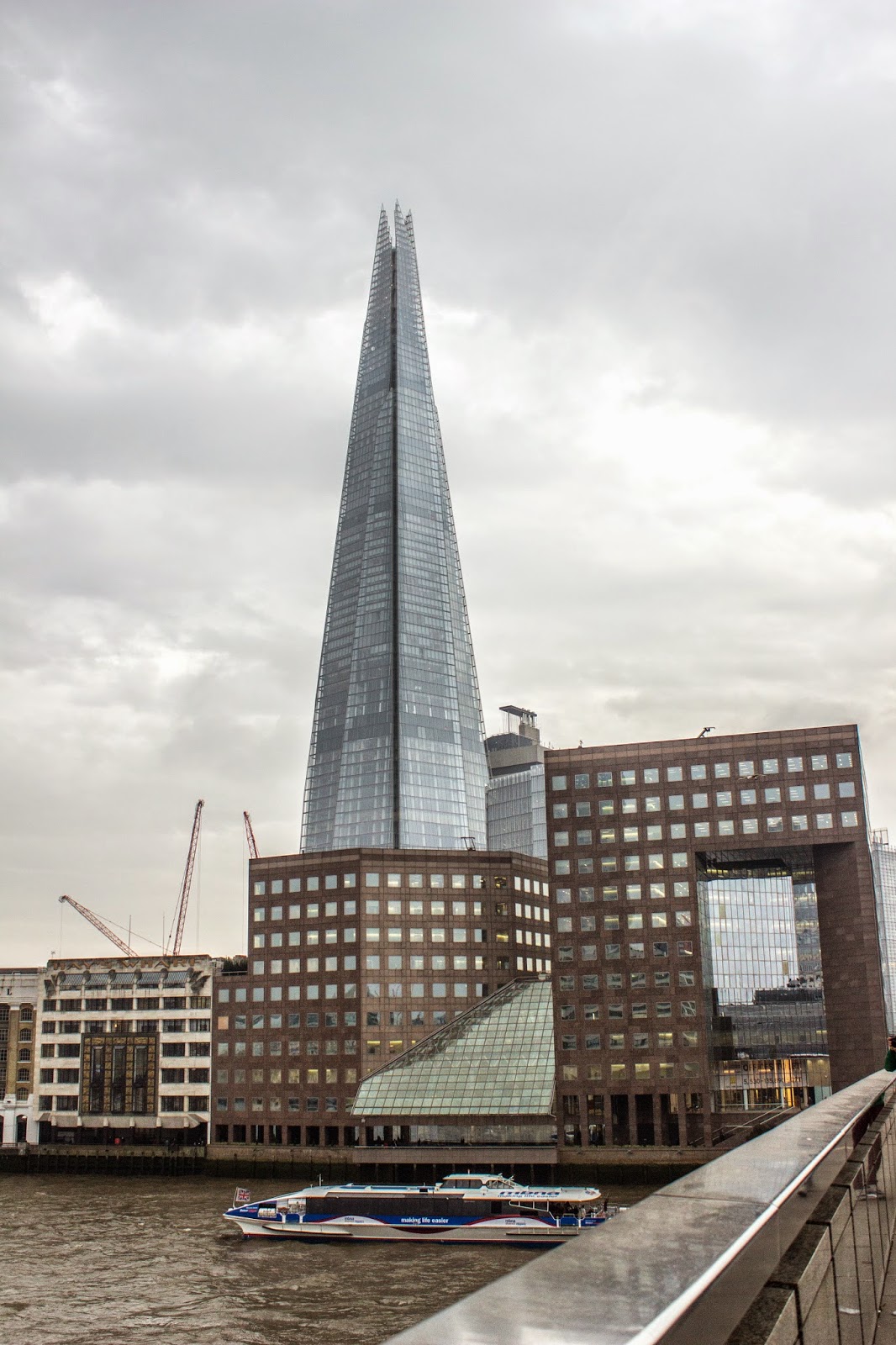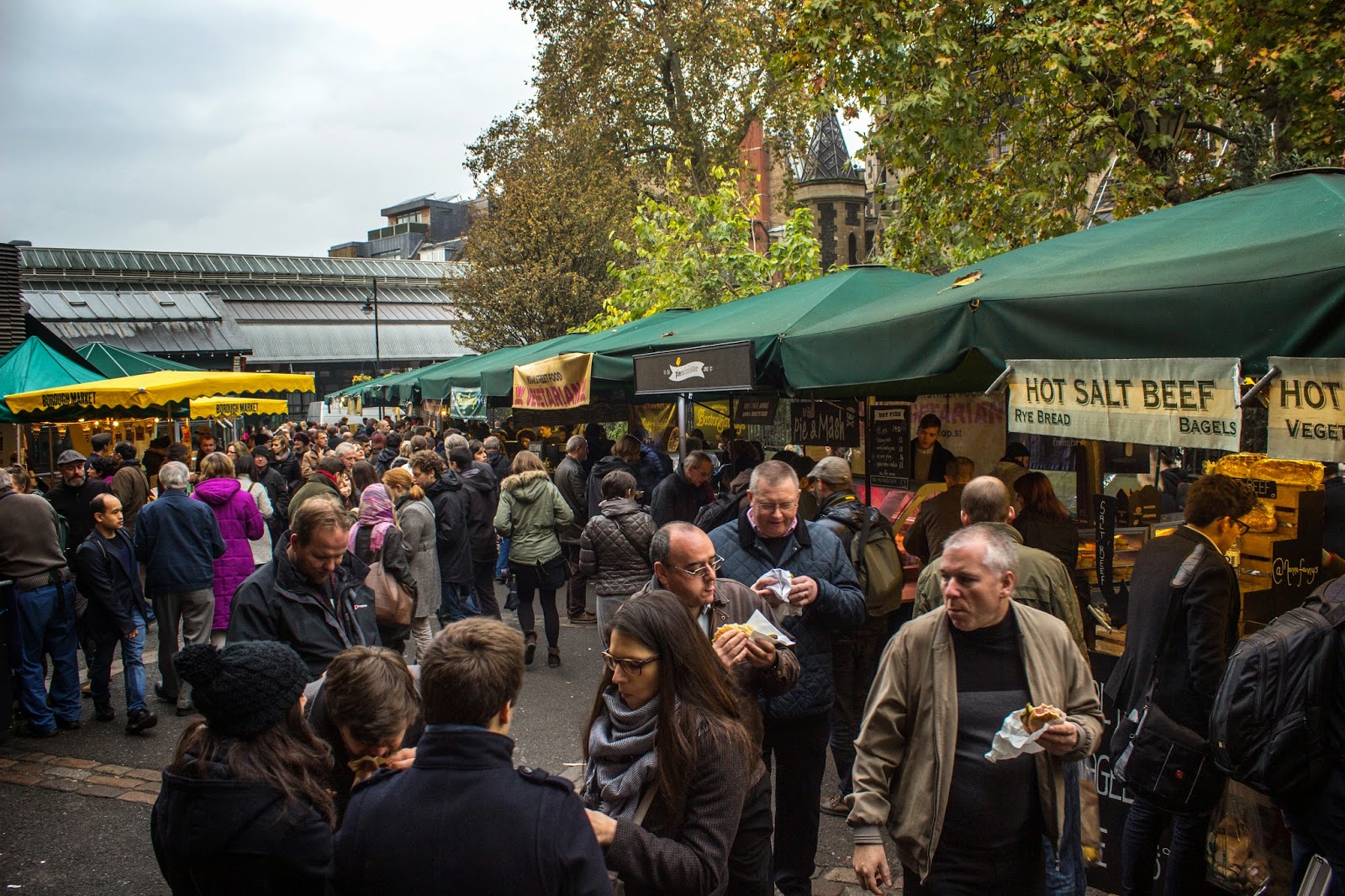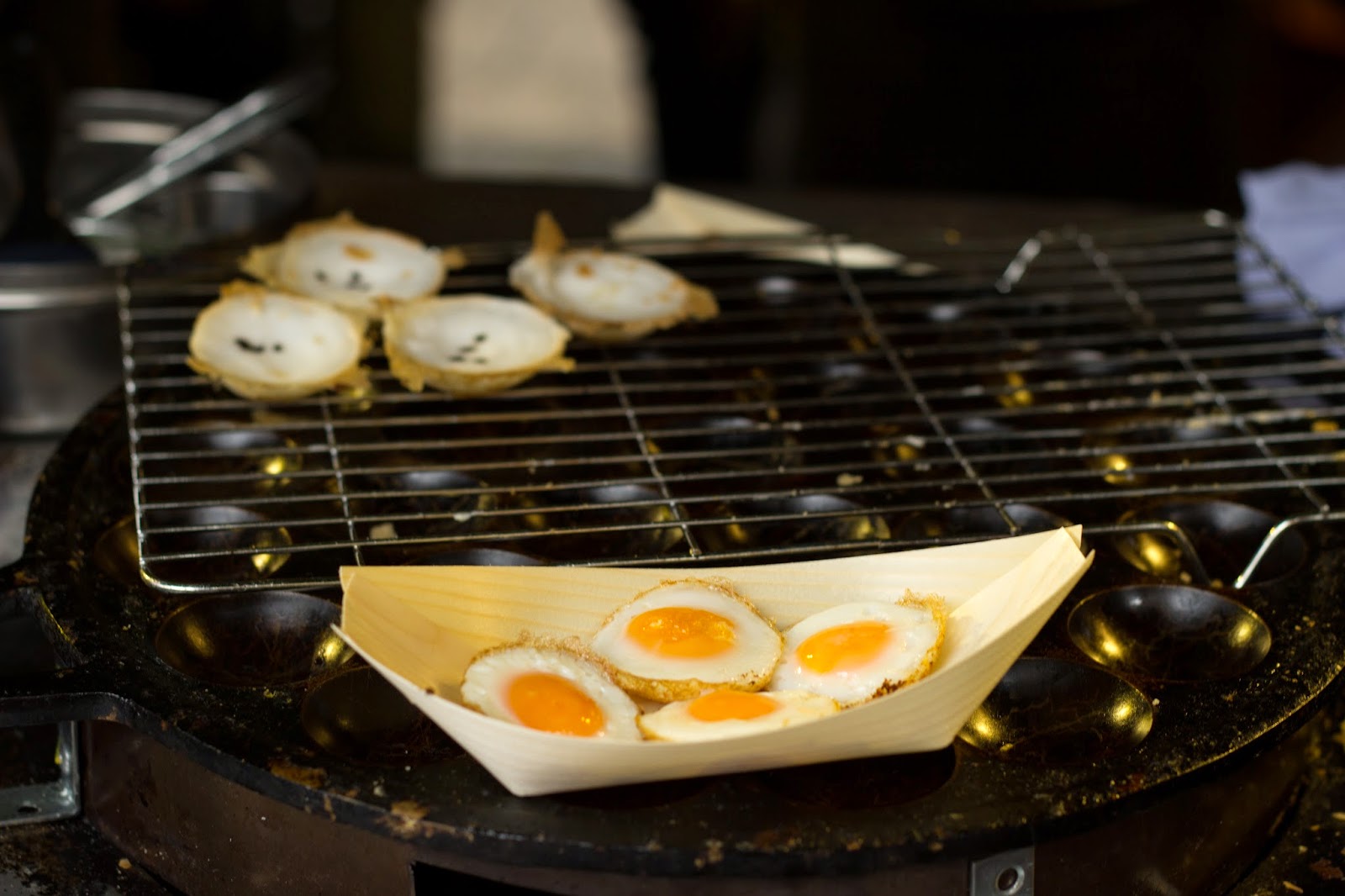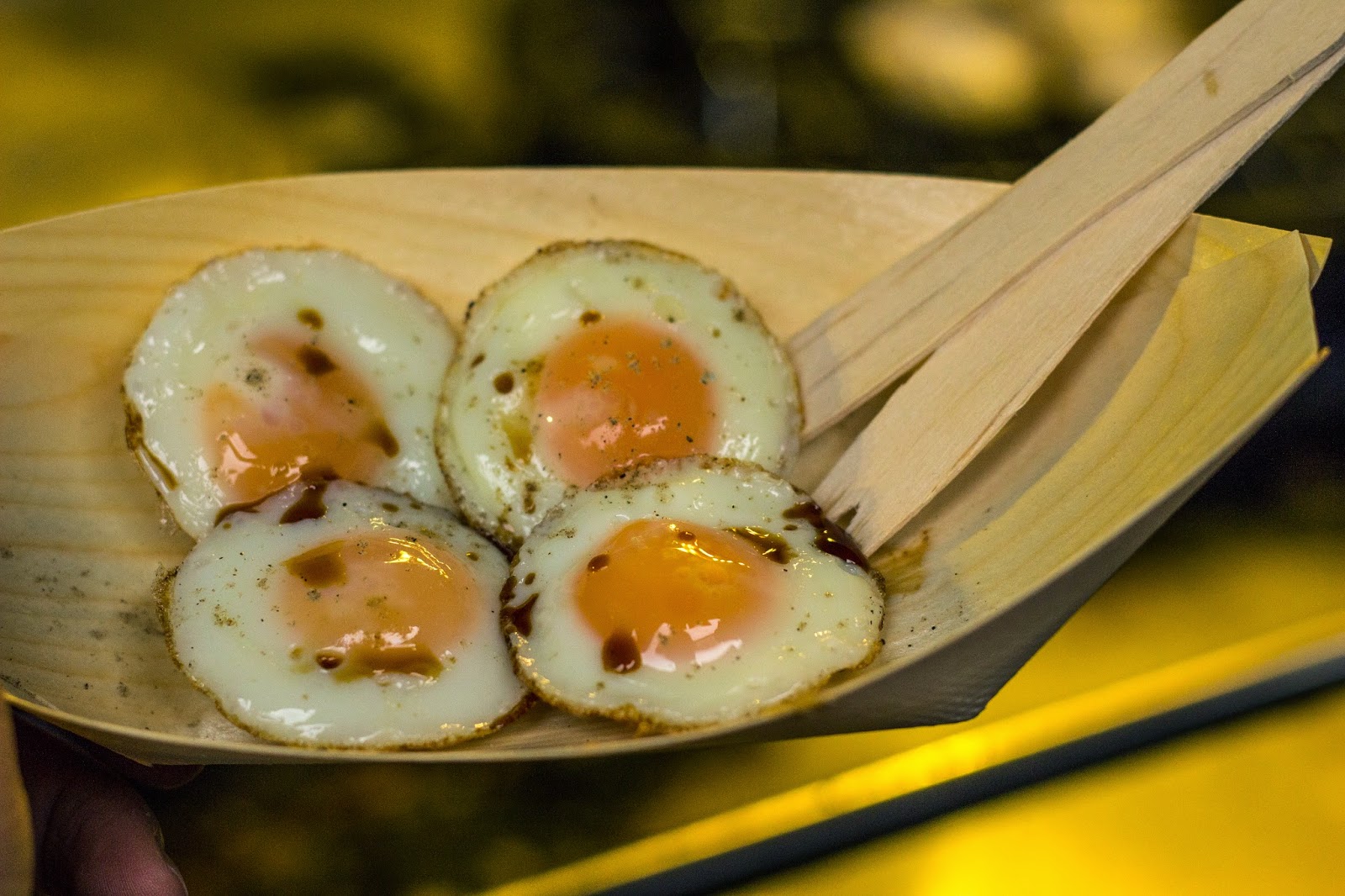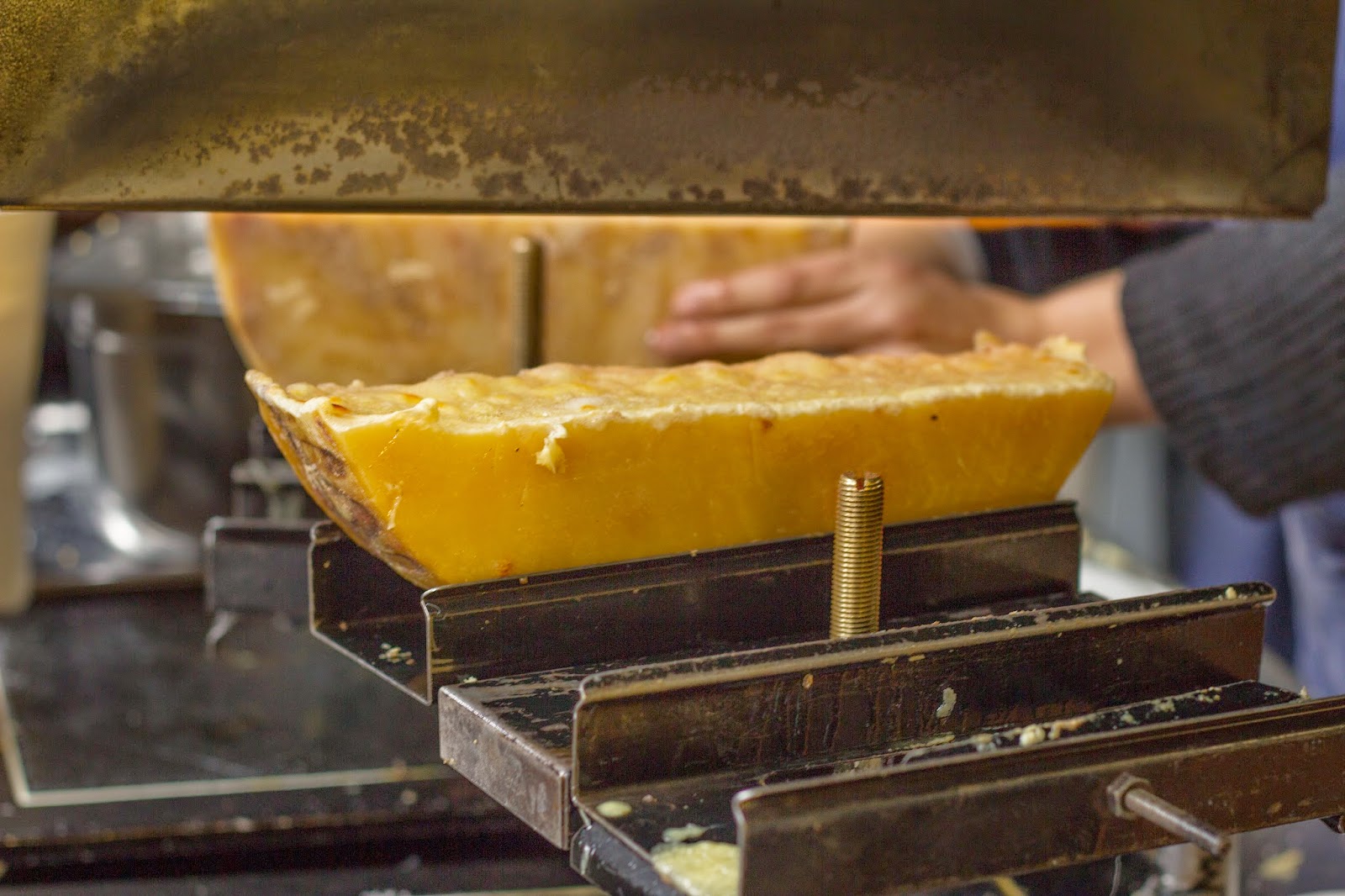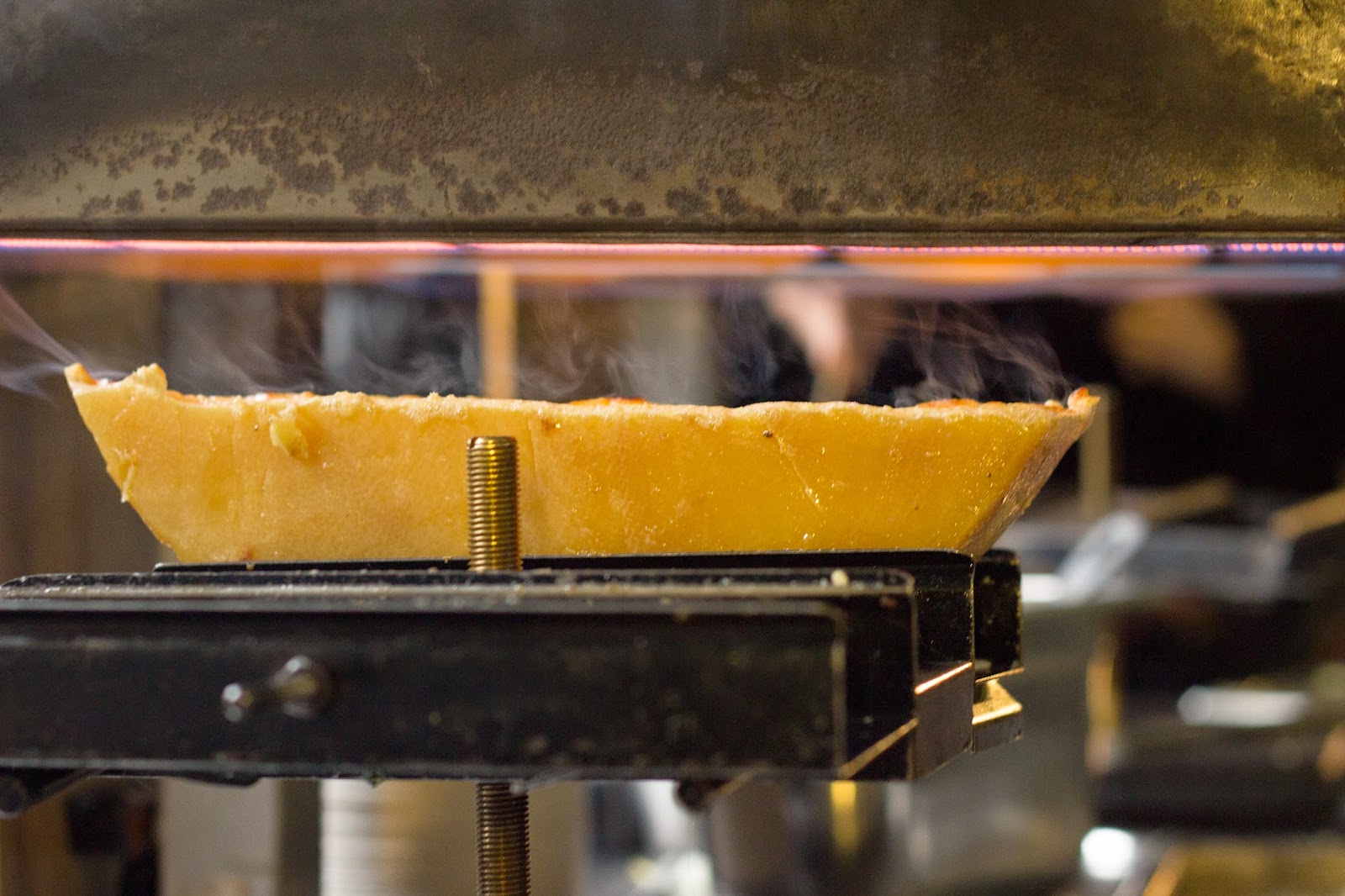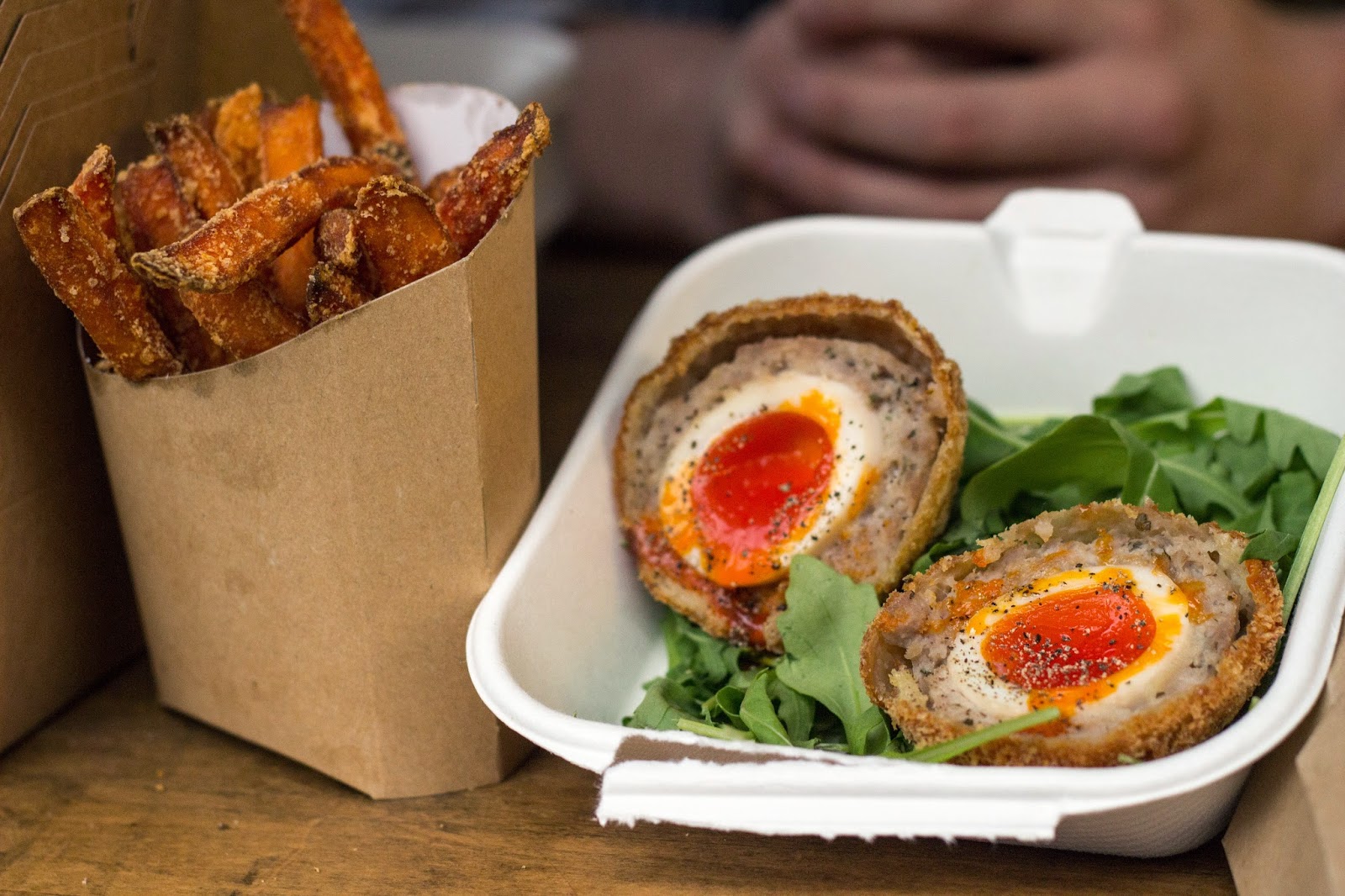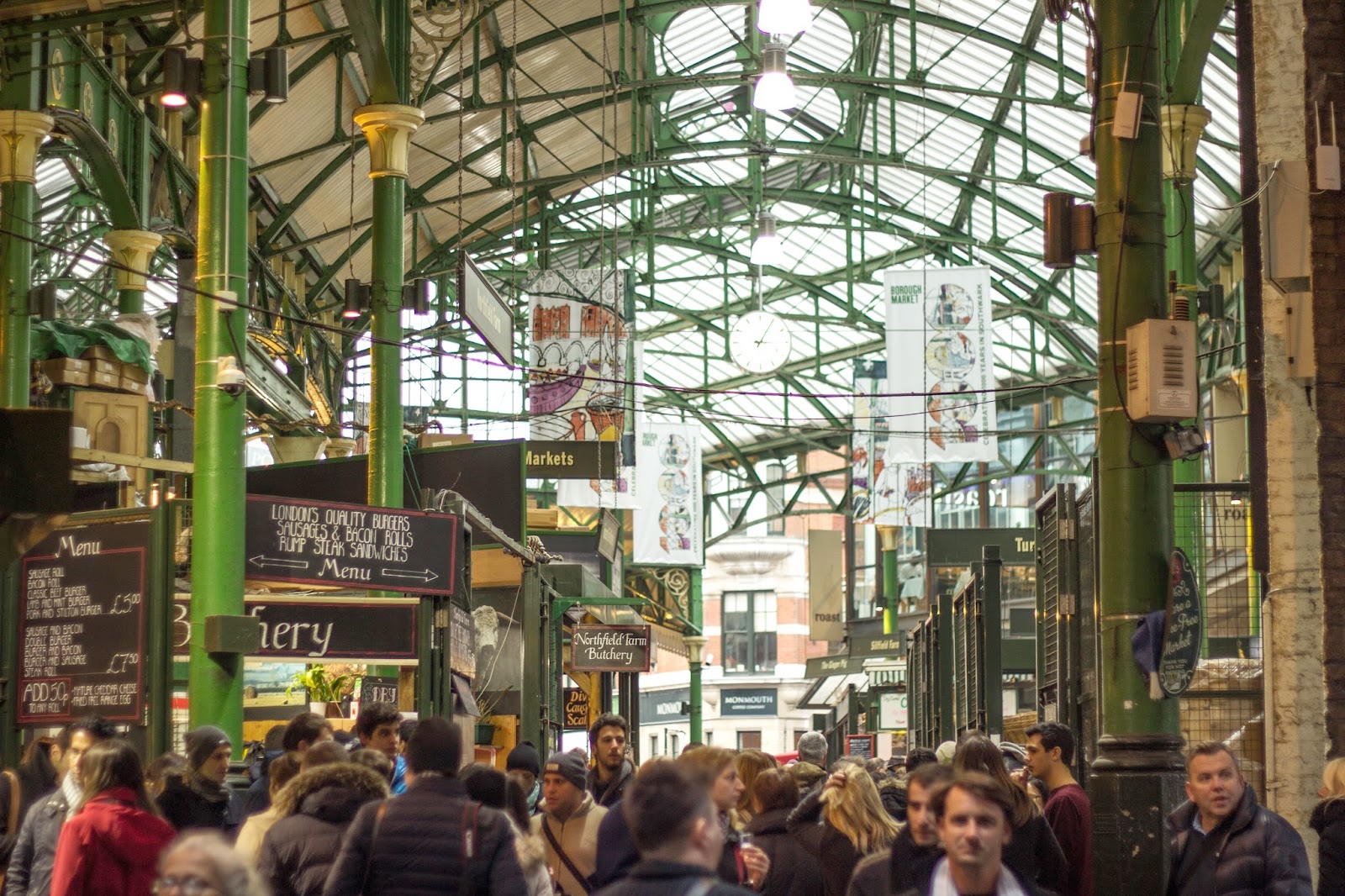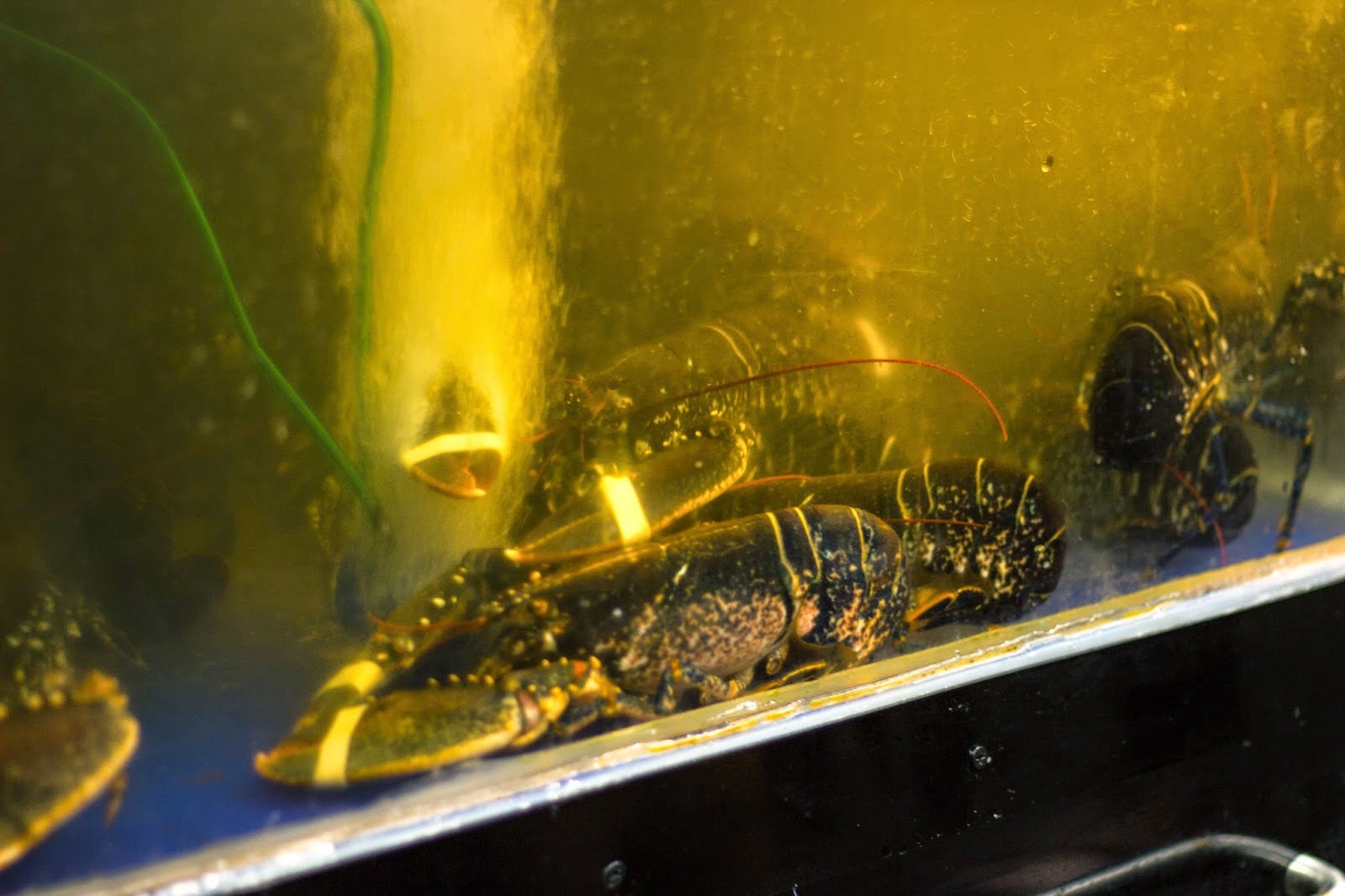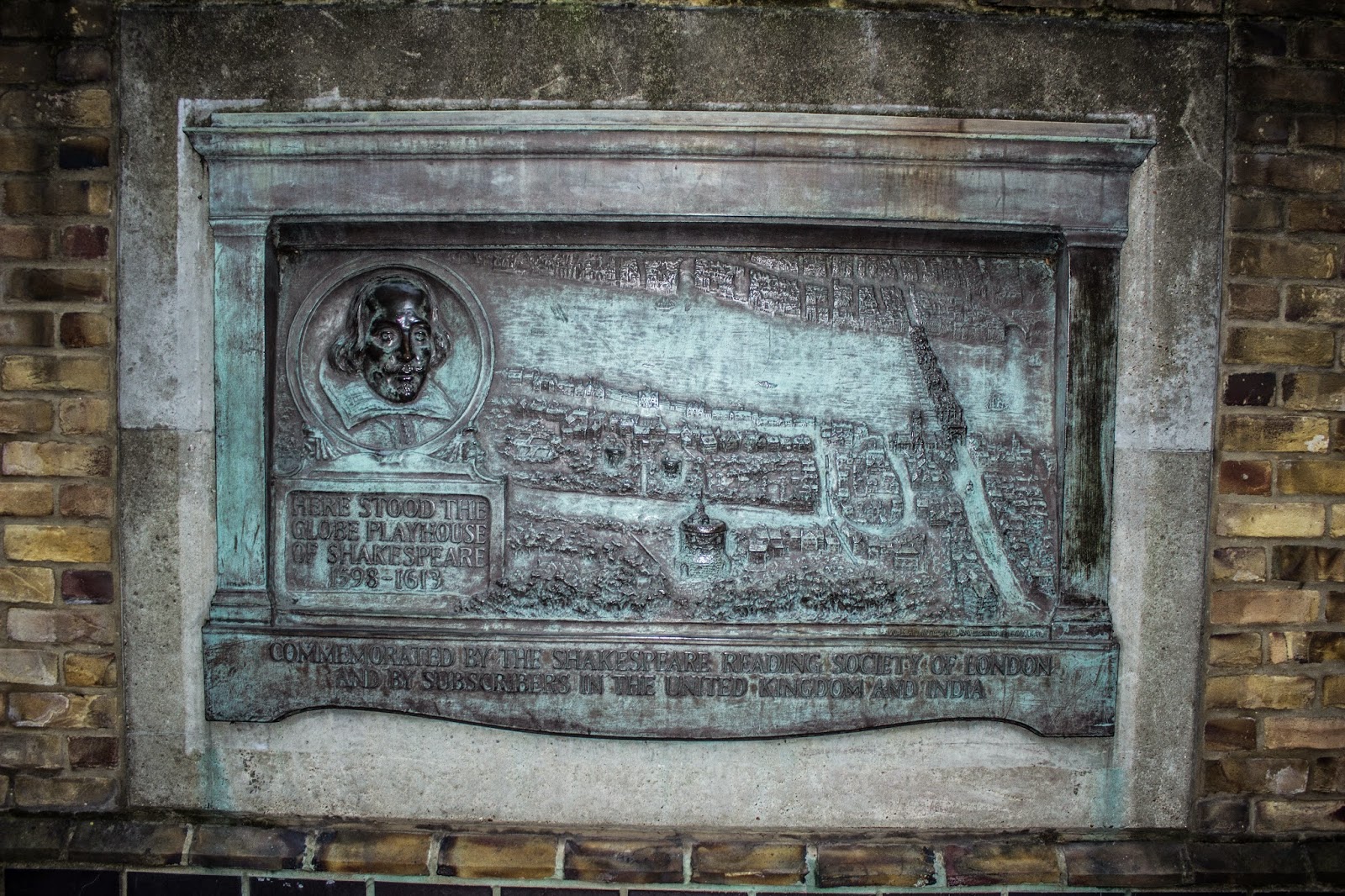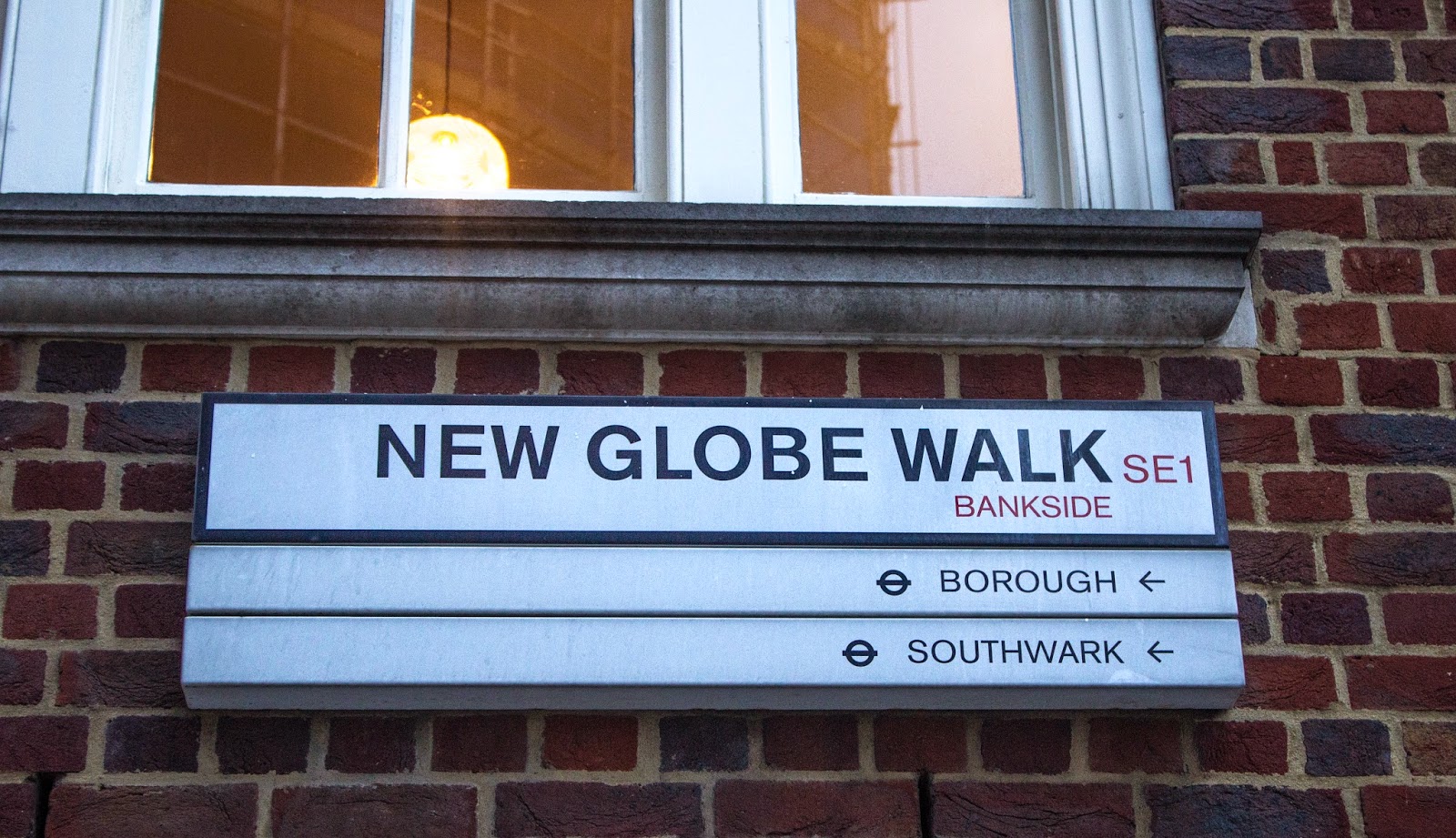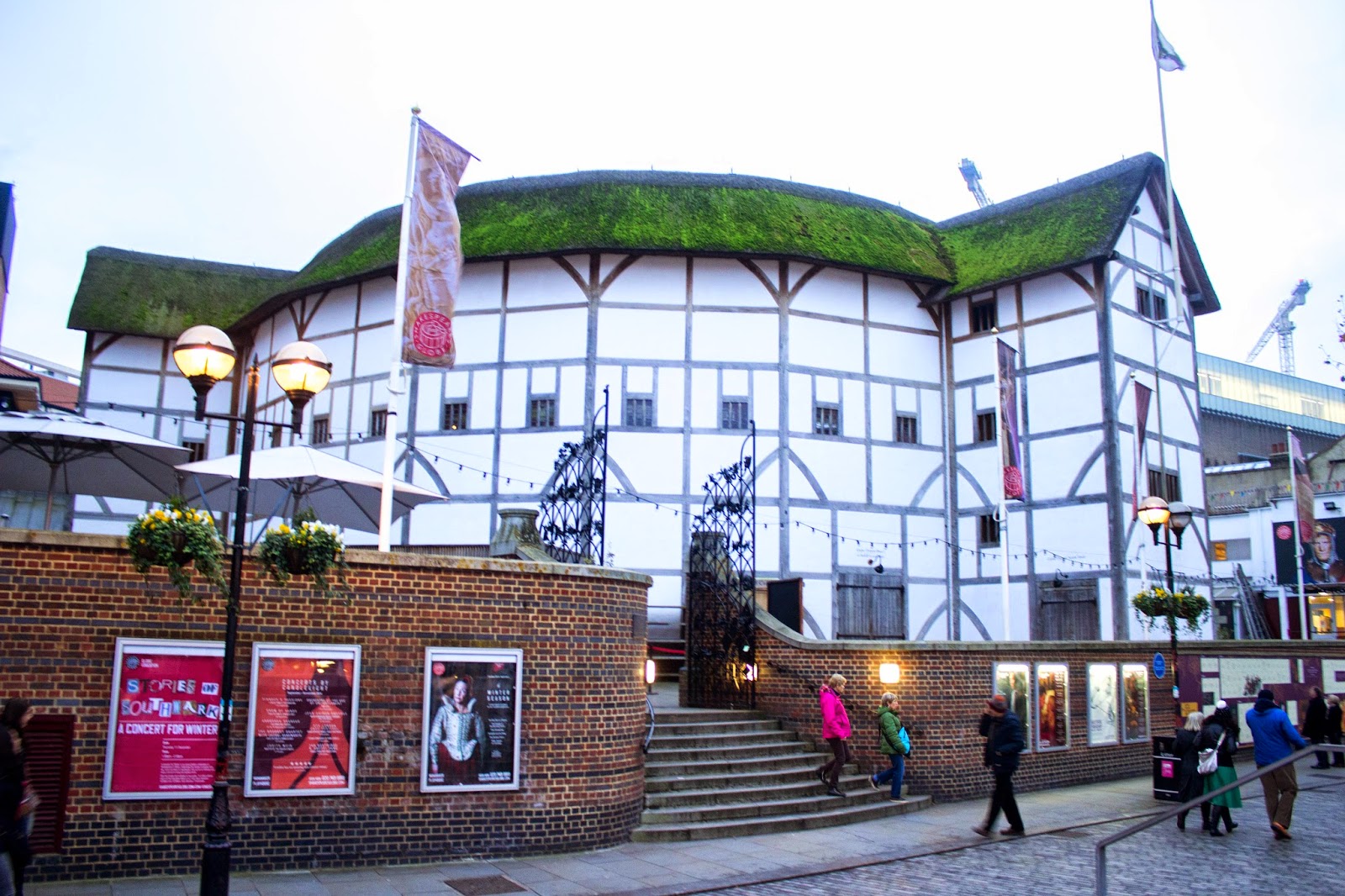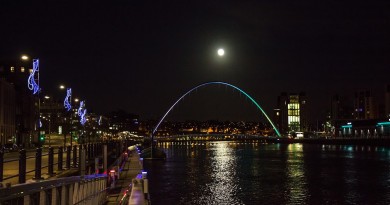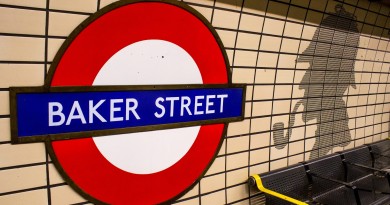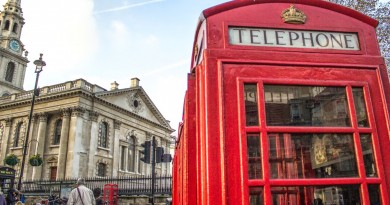Londres (Parte 2) Palacio de Buckingham y Tower Bridge / London (Part 2) Buckingham Palace and Tower Bridge
Quien no vio alguna vez este puente en algún rompecabezas o enciclopedia? Este es el Tower Bridge que muchas veces se confunde con el London Bridge. Con sus característicos turquesas es uno de los más fotografiables del mundo. Pero todavía hay más para ver… Primero vamos al Palacio de Buckingham.
Who hasn’t seen this bridge before – as a jigsaw puzzle or in an Encyclopedia? This is Tower Bridge that is often mistakenly called London Bridge. With its turquoise characteristics- it’s one of the most photographed bridges in the world. But first, let’s go to Buckingham Palace..
Llegamos a la estación que nos lleva al palacio de Buckingham. Caminamos la calle lateral para llegar a tiempo para el «Cambio de Guardia».
We arrived at the station and walked down this Street to arrive in time for the “Changing of the Guards.”
Y nos quedamos a un costado. Todavía falta media hora pero ya hay más de un centenar de personas pegados a la reja esperando uno de los eventos más recomendados de la ciudad. El cambio de guardia es interesante pero no espectacular. Si es de su interés tienen que ir al menos una hora antes para ubicarse en donde les parezca mas conveniente. Este es el cambio de guardia mas famoso de entre todas las residencias reales del mundo. Para mi lo mejor del cambio de guardia fue la banda que toca músicas alusivas a soundtracks de películas como la de Indiana Jones y por supuesto la sincronía con la que se mueven los guardias.
We stood to one side. There was half an hour to go but already hundreds of people were next to the railings waiting for one of the most recommended events in the city. The changing of the guards is the most famous in the world and it is interesting, but not spectacular and yet you have to be there at least an hour early to get a good view. For me, the best changing of the guards are ones that are done to synchronized music like in Indiana Jones.
Mientras, podemos observar todos los elementos que aparecen a nuestro alrededor. Escudos en las columnas, los detalles de las rejas. Estamos en las puertas de la Residencia Real Británica. A pesar que a mi parecer el edificio es mucho menos de lo que esperaba, aun queda pendiente hacer el tour por dentro que solo esta abierto en agosto.
While we were waiting we could look at things around us. Swords engraved on the columns, and the details on the railings. We were at the gates of the residence of the Queen of England. Even though the building was less than I expected, I would still like to do a tour of the palace one day, which is only available during the month of August each year.
El palacio se construyó en 1703 y desde allí ha resistido a bombardeos y guerras. Hoy es el símbolo de la monarquía británica y la realeza tiene mucho cuidado con los gastos y busca evitar todo tipo de despilfarros. Por ejemplo, se sabe que la reina recorre el palacio apagando las luces innecesariamente prendidas. A pesar de esto, es constantemente atacado por los anti-monarquia pero al mismo tiempo admirado no solo por millones en Reino Unido sino en todo el mundo ya que la realeza británica es la que más vende a nivel internacional.
The palace was built in 1703 and since that time it has stood its ground and resisted bombings and wars. Today it’s the symbol of the British Royal monarchy and the royal family takes a lot of care to reduce the costs of running such a place. For example, it is known that the Queen herself turns off lights that aren’t being used. Despite this, the royal establishment is still criticized and attacked by the minority anti monarchists, yet at the same time admired – not only by the millions of British – but also worldwide. The British monarchy is one of England’s greatest assets at an international level.
Pegado al palacio, el famoso Hyde Park, uno de los 8 Parques Reales. Este es un inmenso parque abierto al publico establecido en 1536 cuenta con 141 hectáreas de verde. Lleno de espacios diversos y fuentes es el lugar preferidos de muchos y fue en su momento el elegido de escritores como Karl Marx y George Orwell. Londres es una de las ciudades mas preocupadas por el medio ambiente.
Right next to the palace is the famous Hyde Park. This is one of the eight Royal Parks and is open to the public. It was established in 1536 and consists of 350 acres of greenery. It’s full of different spaces and fountains and its many people’s favourite park. In its time, it was the chosen spot for writers such as Karl Marx and George Orwell. London is one of the greenest cities in the world.
Y aquí otro de los ejemplos de la sencillez de Londres, que es una atracción en esta ciudad? Los policías! Si señores, su uniforme esta en miles de ítems en las tiendas de souvenirs. Extremadamente amables acceden esporádicamente a tomarse fotografías con los turistas. Londres esta llena de turistas pero al mismo tiempo no encontrás ninguno. Es algo inexplicable y especialmente notorio luego de visitar las grandes ciudades turísticas de Europa. Londres te da todo lo bueno sin todo lo malo.
Here we see another example of the simplicity of London and another of its attractions – The Police! Yes Sir – their uniform is amongst many of the souvenirs you can buy here. They are extremely polite and are often seen having their photos taken with tourists. London is full of tourists, yet at the same time you don’t notice them. It’s something inexplicable and yet so different compared to other cities in Europe. London gives you all the good it has to give, and none of its bad.
Aqui tenemos un ejemplo de los taxis londinense. Estos taxis son normalmente negros y ocasionalmente de otros colores, pero tienen en común el diseño. Ademas de ser famosos por su belleza es también de mundial conocimiento lo complicado de los exámenes que otorgan el permiso para conducirlos. Son 320 rutas que hay que conocer, las 25.000 calles y los más de 15.000 puntos de interés. Dicen que después de 3 o 4 años de estudio uno esta preparado para rendirlo. El conocimiento que deben tener es de 10km de radio teniendo en cuenta como punto central Charing Cross. Si nos cruzamos con alguna moto donde una persona esta con un gran mapa enfrente y chaleco fosforescente probablemente es uno de los estudiantes del Knowledge como se llamada cariñosamente al Knowledge of London (Conocimiento sobre Londres), el nombre que lleva este dificilísimo examen. Se llama así porque tambien los taxistas son famosos por el conocimiento que tienen para hacer distintas rutas teniendo en cuenta el trafico y las necesidades del cliente sin necesidad de ningún mapa, asistencia telefónica o tecnología GPS.
Here we have a London Taxi or London Cab. These taxis are normally black and occasionally other colours, but are all of the same design. Apart from being famous for their beauty – it’s a well-known fact that the written exam to be able to drive one of these is extremely complex. The taxi driver needs to know the 320 different routes, the 25,000 street names and more than 15,000 places of interest. It’s said that it takes 3 to 4 years to study and prepare to be able to sit this exam. If you go past anybody on a motorbike and they have a street map, and are wearing a fluorescent jacket – it’s probably a “Knowledge” student. This extremely difficult exam is affectionately known as “The Knowledge” (the London Knowledge exam) and London taxi drivers are famous for their intricate knowledge of the streets of London. They have to know and find their way in and around London every day, taking into consideration the traffic and the needs of each client, without consulting a map or using their telephones or GPS.
Se cuenta que todo esto tuvo origen en 1851, cuando una gran expo (el origen de la expo como conocemos) se hizo en Londres y los visitantes se quejaban de que los «taxistas» con caballos y carruaje no tenían idea de a donde tenían que ir. El príncipe Alberto, esposo de la Reina Victoria sugirió que los taxistas tenían que tomar un examen para poder trabajar.
Apparently – this originated in 1851, when there was a big Expo in London. The visitors complained that the” taxi drivers” with their horse and carriage – didn’t know where they were going. Prince Albert, Queen Victoria’s husband suggested that the Taxi drivers should pass an exam to be able to work.
Frente al palacio esta la plaza y esta es famosa porque es un memorial a la reina Victoria. La reina Victoria gobernó por 64 años y toda una época tiene su nombre, la época victoriana. Esta estatua de mármol blanco ademas representa muchos aspectos de su carácter, como la justicia, caridad y otros. La imagen dorada es «La Victoria».
In front of the place is this square. It’s famous for its memorial of Queen Victoria. Queen Victoria reigned for 64 years and a whole era is named after her – The Victorian Era. This marble statue represents many aspects of her character, such as justice, charity and many others. The bronze statue is known as: “Winged Victory.”
Desde aqui vamos al Tower Bridge y pegado al puente encontramos el Tower of London, el edificio donde se guardan las joyas de la corona. Esta abierto al publico y en la ocasión en que lo visitamos, no entramos, pero por fuera todavía habían restos de lo que fue una instalación impresionante.
From here we can see Tower Bridge and almost attached to the bridge is the Tower of London. This is the building where the crown jewels are kept. It’s open to the public and this time we didn’t go in, but just looking and observing from the outside – we were impressed by its magnificence.
Antes de hablar sobre esta obra de arte les comento que en la fecha que visitamos ya estaban retirando gran parte de la instalación, por eso hay estas tiendas y carretillas. Decidimos ir al Tower Bridge antes y así después ver con tranquilidad esta maravilla de instalación.
Before I speak about this amazing work of art, I need to explain that on the dates we visited, they were already removing a big part of it, so we decided to go to Tower Bridge first so that we could look at this amazing display another time, when things were a bit quieter.
Como pueden ver, teniendo en cuenta los colores de la muralla sobre la estamos apoyados, estamos sobre la calle a menos de 50 metros de Tower Bridge.
As you can see, taking into account the colours, we are leaning on a wall on the street about 50 metres from Tower Bridge.
Este puente tiene en su pagina los días en que será abierto y es un espectáculo que no se pueden perder, nosotros nos lo perdimos, pero como decimos, más motivos para regresar.
This bridge has its web site showing the days on which it will open and it’s a spectacle not to be missed. We actually missed seeing it open and that’s another good reason to come back.
Desde aquí podemos ver los edificios modernos más llamativos, a la izquierda del río Támesis. Al fondo, el puente que vemos es el London Bridge. El barco que se ve a la izquierda es el HMS Belfast y es un buque británico de guerra que «peleó» durante la Segunda Guerra Mundial, hoy es un museo flotante.
From here we can see the most modern buildings to the left of the River Thames. In the background is London Bridge. The boat on the left is HMS Belfast – it’s a British warship that fought in the Second World War and today is a floating museum.
El edificio con forma semiesférica que vemos a la izquierda es el City Hall, el ayuntamiento. Es visitable y dentro es mucho mas impresionante que por fuera dicen. Inaugurado en 2002 el diseño es de Norman Foster. El edificio alto y puntiagudo es The Shard, inaugurado en 2012, tiene 309 metros de alto y es actualmente el edificio más alto de Europa. Le sigue el Commerzbank en Frankfurt.
The round bulbous shaped building is City Hall, which is the town hall. You can visit it and it’s much more impressive on the inside than it is on the outside. It was designed by Norman Foster and it opened in 2001. The tall pointed building is The Shard and it opened in 2012 – its 1004 feet high and is the tallest building in Europe. The second tallest is the Commerzbank in Frankfurt.
El Tower Bridge también es visitable, se puede ver el antiguo sistema que servia para levantar el puente, y arriba cuenta con una pasarela con piso de vidrio lo cual hace más interesante la experiencia.
It’s also possible to visit Tower Bridge and see the old fashioned system of raising the bridge and above that is a walkway with glass floor which makes the experience even more interesting.
Finalmente vamos hasta la entrada del Tower of London llamado oficialmente Her Majesty’s Royal Palace and Fortress (El palacio y fortaleza real de su Majestad), a ver de cerca la instalación de amapolas rojas.
Finally we arrive at the entrance of the Tower of London – officially called Her Majesty’s Royal Palace and Fortress, and here we see the huge artistic installation of red poppies.
Este castillo construido en 1066 fue utilizado con muchos fines a través de los años. Funciono como prisión (los últimos prisioneros fueron los Hermanos Kray en 1952), como fortaleza, como refugio, como observatorio, como armería, como Casa de la Moneda. En su tiempos de prisión utilizaba muchos elementos de tortura los cuales se encuentran también expuestos dentro. También es famoso este lugar pues aquí fue decapitada Ana Bolena acusada de traición.
Cada día se realiza el acto de «entrega de llaves» por los guardias del lugar (los cuales viven dentro) y esta es considerada la ceremonia militar continua más antigua del mundo ya que se realiza hace más de 700 años.
This castle was built in 1066 and has had many different uses over the years. It has served as a prison (the last prisoners were the infamous Kray twins in 1952) – it has served as a fortress, as a refuge as an observatory, as an armoury and home to the royal mint and the crown jewels. On display are different items used in torture when it was a prison. This place is also famous for being where Ann Boleyn was beheaded for treason.
Every night there is the “Ceremony of The Keys”, which involves the formal locking of the gates of the Tower of London, and the handing over of keys to the next guards. This ceremony has been carried out every night for more than 700 years.
Esta instalacion se llama Blood Swept Lands and Seas of Red y significa La Sangre Arrasó Rojas Tierras y Mares. Son 888.246 amapolas de ceramica que representan a los soldados británicos que perdieron la vida en la Primera Guerra Mundial. El 11 de Noviembre de 2014 se instaló simbólicamente la ultima flor ya que ese día se celebra Poppy Day o Día del Armisticio y son 100 años del comienzo de la Primera Guerra Mundial. Estuvieron presentes los miembros de la realeza y se leyó la lista de nombres de los soldados, lo cual se hizo cada tarde de los días que duró la exposición, para luego guardar dos minutos de silencio. Poppy es amapola en ingles y como mencioné en el post anterior es la flor que se utiliza simbólicamente en honor a los caídos en guerra. En 2014 se recuerdan los 100 años desde el inicio de la Primera Guerra Mundial y esta instalación es la manera de honrar a todos los soldados que perdieron su vida en ese horrible evento.
This art installation is called Blood swept lands and seas of Red symbolizing the shedding of blood on land and at sea. There are 888,246 ceramic poppies representing the British soldiers who lost their lives during the First World War. On 11 November 2014 the last poppy was put here as a symbol to represent poppy day or Armistice day – it was especially significant being a hundred years since the start of the first world war. The Queen and other members of the royal family were present and the names of all of the soldiers were read out and then there was a minute’s silence. Poppy is the flower used to remember the soldiers who died at war.
Esta fantastica instalación es obra de Paul Cummins y Tom Piper. Durante los días en que estuvieron completamente expuestas, más de cinco millones de personas pasaron a visitar y participar del acto conmemorativo, mucho de ellos son veteranos o familias de los soldados cuyas vidas se honra con dicha instalación. Las flores comenzaron a colocarse en julio y finalizaron el 11 de noviembre cuando se comenzaron a retirar en distintas etapas para permanecer exhibidas hasta el ultimo día de noviembre. Esto también se debe a lo delicado de las flores. Al ser cerámica no están preparadas para soportar las inclemencias del tiempo. Muchas de ellas estaban ya rotas o caídas.
This fantastic installation is work of Paul Cummins and Tom Piper. During the days of the full installation more than 5 million visitors came to see the poppies. Many of them were veterans or family members of soldiers who were being honoured in such a memorable way. The first flowers were placed in July and the last one was placed on 11th November. The exhibition lasted until the end of November when the last flower was removed. One of the reasons they couldn’t be on display longer was that the poppies were made of ceramic and unable to withstand extreme cold. Many of them were already cracking.
Fueron tantas las personas que visitaban diariamente la instalación que las estaciones cercanas de metro tenían que cerrarse en horarios pico debido a que colapsaban. El trabajo que llevo hacer estas flores artesanalmente, 3 turnos para que el trabajo sea 23 horas al día. No acostumbro a poner vídeos pero este es impresionante
There were so many visitors coming to see the poppy installation every day that they had to close the nearby underground stations during rush hour. These flowers were individually handmade and so that the work could be completed on time there were three shifts in 23 hours every day. I don’t usually post videos – but this is impressive.
Cada una de estas flores fue vendida online a 25 libras, dio un resultado de más de 40 millones de libras las cuales fueron repartidas entre 6 organizaciones benéficas relacionas a la guerra.
Each one of these flowers was sold on line for 25 pounds – making more than 40 million pounds, much of which was distributed between six war- related charities.
Ya nos retiramos pero no sin antes fotografiar a estos leones y recordar que en este recinto existía antes una «Casa de Fieras» es decir que, aquí habían animales salvajes. Estos animales empezaron a acumularse en el siglo 18. Leones, monos, camellos y, aunque parezca increíble, un oso polar al que eventualmente dejaban que se acerque al río para lavarse y cazar algún pez. También un elefante que fue el primero en llegar al país. Además, cada año los reyes recibían más animales de regalo, se iban sumando y continuaron sumando a través de los años. Avestruces, águilas, ardillas, cebras, canguros, oso grizzli, panteras, tigres y más. En principio estaban cerradas las puertas pero más adelante fueron abiertas al publico. Eran mas de 280 animales los cuales llegaron a ser demasiado para el lugar. Fue así que se decidió en 1830 entregarlos a la Sociedad del Zoológico de Londres.
Before we leave here I want to share a photo of these lions and remember that they lived in here in the Royal Menagerie. This place accommodated wild animals, which belonged to the Royal family. These animals started to arrive here in the early 18th century. Most of them were gifts to the Royal family. There were lions, monkeys, camels and even a polar bear at one time was kept here and it was put on a long leash and allowed to swim in the River Thames to bathe and catch fish. An elephant was the first to arrive in the country. Each year the King of England would receive more animals as gifts and over the years in this place – there were ostriches, eagles, zebras, kangaroos, grizzly bears, panthers and tigers and many more. At first the menagerie was closed to the public and was just a private collection of animals that belonged to the King, but then it was opened for the public to visit. When the number reached 280 – it was too many for this place and in 1830 they were given to London Zoo in Regents Park.
Desde aquí vamos caminando a otro punto importante…
From here we walked to another important place..
Las calles tienen escrito el lado al que debemos mirar antes de cruzar.
Abajo, un claro ejemplo del contraste de moderno y antiguo en las calles de Londres.
On the roads it is clearly written which way you should look before crossing.
Here is a classic example of the contrast between old and new on the London Streets.
Llegamos al Monumento del Gran Incendio de Londres. Esta torre por la que se puede subir para tener una vista 360 de la ciudad, tiene 61 metros de altura y esta ubicada a 61 metros de donde inició el gran incendio en 1666. El monumento se termino en 1677. El Gran Incendio duró 3 días y destruyó 13.200 casas y muchas iglesias y edificios importantes como el ayuntamiento y la Catedral de San Pablo. El fuego empezó en una panadería y se extendió a causa de los fuertes vientos y las malas decisiones del alcalde. Hoy es recordado como uno de los más desastrosos eventos de la ciudad.
We arrived at the Monument of the Great Fire of London – Simply known as” The Monument”. It’s a column that has a 360 degree view of the city. Its 202 feet high and is 202 feet from where the Great Fire of London broke out in 1666. This monument was finished in 1677. The Great Fire of London lasted three days and it destroyed 13,200 houses and many churches and other important buildings such as the town hall and St.Pauls Cathedral. The fire had started in a bakery and due to strong winds and bad decision making by the mayor of London- it spread very quickly. Today it is recorded as being one of the most disastrous events the city has seen.
Luego de subir 331 escalones se llega a la cima. No subimos pues en otro monumento parecido tuve un episodio de claustrofobia así que preferí dejar la vista de arriba para los más osados.
You get to the top by climbing 331 stairs. We didn’t go up because in a similar monument I had experienced claustrophobia. We left the view at the top to the brave.
A pasitos de la torre llegamos al London Bridge. El verdadero. Como comentamos al inicio del post, este es constantemente confundido. Es tal la confusión que se produce entre este y el Tower Bridge que cuenta la leyenda que una vez fue vendido el London Bridge a alguien que en realidad quería comprar el Tower Bridge.
We soon arrived at London Bridge – The real London Bridge. As I mentioned earlier this bridge is often confused with Tower Bridge, so much so that there’s a story of how this bridge was sold to someone who actually thought they were buying Tower Bridge.
Particularmente famoso en la cultura anglosajona pues una música infantil habla sobre el London Bridge que se esta cayendo y esta rima fue convertida en música y luego en juego. Al ser el Tower Bridge el más fotografiado y divulgado muchos vienen emocionados al London Bridge a ver parte de su niñez materializada y decepcionados miran al Tower Bridge desde lejos.
En realidad, a pesar de parecer poco interesante, existe una historia fascinante detrás. El lugar donde esta construido es el mismo del único y mas viejo puente de Londres. El mismo fue construido en el año 43 DC y se cree que el origen de la música proviene del miedo que tenían a que el puente se caiga.
There’s a famous children’s song and game in Anglo-Saxon culture that is all about London Bridge falling down. Many people come to visit this bridge expecting to see something special and are often disappointed and so they stare at Tower Bridge further down the river.
In fact – as dull as it is – it is a fascinating bridge as it’s on the exact site of what was the oldest and only bridge in London that had been originally built in 43 AD and it’s believed that the song was written as there were always fears that one day it would fall down.
Olvide tomar una foto general del puente pero como pueden ver parte de la baranda, no hay nada de especial que ver.
I forgot to take a full photo of this bridge – but as you can see by the handrail – there’s nothing special to see.
Con mucha hambre vamos a visitar el Borough Market, un lugar más que recomendado para cualquier viajero amante de la cocina local.
Very hungry we made our way to Borough Market. This is a place that’s highly recommended by every traveller, who loves local cuisine.
Al costado de la Catedral Southwalk se encuentra uno de los mercados mas antiguos de la ciudad. Funciona de miércoles a sábados y aquí encontramos comidas de todas partes del mundo así como también todo tipo de especias, tes, y productos frescos para cocinar una rica cena.
One of the oldest markets in London can be found next to Southwalk Cathedral. Its opening days are Wednesday to Saturday and it has food from all over the world. It also sells spices and teas and fresh produce for cooking a tasty dinner.
Los más sabrosos huevos fritos de codorniz que comí en la vida.
The tastiest fried quail’s eggs I’ve ever eaten in my life.
Raclette, queso suizo que se calienta y luego, la parte derretida es «empujada» sobre un colchón de papas hervidas.
Raclette – Swiss cheese that you heat it up then the melted cheese is spread over a bed of boiled potatoes.
Esto de abajo es una delicia! Lo mejor que comí en esa feria. Scotch Egg, es un huevo a la escocesa que consiste en huevos casi cocinados por completo, es decir que la yema todavía liquida pero bien firme la clara, envueltos en una masa hecha con carne y salchichas picadas finamente y empanados en pan rallado que luego se pone a freír. Para comerlo se parte al medio y con un poco de pimienta se convierte en lo más delicioso del mundo. A pesar de su nombre, no son de origen escocés sino que fueron inventados en una tienda en Londres en 1738.
Scotch eggs were the best thing I ate at this market. It consists of a hard-boiled egg which is then wrapped in sausage meat and breadcrumbs and then fried. To eat it you cut it in half and with a bit of pepper it is transformed into one of the best delicacies ever. Despite its name, they don’t originate from Scotland. In fact, they were invented in a London shop in 1738.
El mercado se cree existe desde 1014 o más, antes estaba ubicado en otro sitio pero tuvo que ser cerrado y reubicado en 1754 por orden del parlamento debido a la congestión que se producía alrededor.
It is believed that this market has been in existence since 1014, where it was in a different location and had to be officially closed and relocated in 1754 due to the traffic congestion it was producing.
El Borough Market es ganador de muchos premios y cada año suma alguno a la colección. La mejor experiencia gastronómica de Londres, el mejor sitio de Slow Food, la mejor experiencia de Londres, son algunos de los ejemplos.
Borough Market has won many prizes and awards and every year more are added to its collection. The best gastronomic experience in London, The best place according to Slow Food and The Best London Experience are amongst its awards.
Antes de salir no pudimos evitar la tentación de probar este sandwich de 3 quesos, creación de la tienda que los vende. Montgomery cheddar, queso Comté y queso Oglieshield. Para completar el sabor, puerro fresco, ajo y muchísimo sabor!
Before we left we couldn’t resist the temptation to try this three cheese sandwich – a specialty of the house. Montgomery Cheddar, Comte cheese and Ogleshield cheese. To complete the sandwich and make it even tastier, fresh leek and garlic are added
El mercado es una mezcla de sabor y color además de estar impecablemente limpio lo que hace que la experiencia sea aun más agradable. Una de las visitas mas memorables de las que hicimos en nuestro tiempo en Londres.
The market is a mixture of taste and colour and it’s also impeccably clean, which makes the experience even better. It’s one of the most memorable visits that we had, during our time in London.
A unas pocas cuadras está el lugar donde originalmente se encontraba el teatro de Shakespeare. El Globe Playhouse of Shakeaspeare.
Construido en 1598 por la compañía de teatro de Shakespeare, fue destruido por un incendio en 1613. Un nuevo edificio fue construido en ese lugar en 1614 y cerrado en 1642 por presión de los puritanos y demolido finalmente en 1644. Hoy solo una pequeña placa nos recuerda el lugar en que se encontraba.
A few streets from here is where the Original Shakespeare Theatre once stood: The Shakespeare’s Globe Theatre.
Built in 1598 by the Shakespeare Theatre Company, it was destroyed by fire in 1613. The theatre was rebuilt in 1614, but was officially closed by pressure of Puritan opinion in 1642, and demolished in 1644. Today there is a small plaque that reminds us of the place, where it originally stood.
A 230 metros de ese lugar la nueva Shakespeare Globe esta ubicada. En 1997 una moderna reproducción del edificio fue inaugurada y abierta al publico con la obra Henry V. Mirando al río el edificio circular es producto de muchísima investigación para hacer la estructura lo más similar posible a la original. Tal es así que las obras presentadas aquí son realizadas de la manera en que fueron presentadas en aquel tiempo, a la luz del día, sin micrófonos ni parlantes, con música en vivo aportando elementos únicos a esta extraordinaria experiencia.
250 yards from here we come across the new Shakespeare’s Globe. This theatre was built in 1997 and is a modern reproduction of the same building. Its opening play on its opening night was Henry V. Looking out at the river you can see that the circular shape of the building fits with a curve in the river and its evident that a lot of investigation took place to make this building to look as close as possible to the original one. In the same way the plays that are shown here are represented in the same way that they would have been presented originally – in daylight, no microphones or speakers and with live music – making this an unforgettable and unique experience.
Con este maravilloso homenaje a Shakespeare nos despediremos hasta la próxima semana donde podrán conocer más sobre la maravillosa Londres!
With this fantastic tribute to Shakespeare we say goodbye, until next week, when we will discover more about amazing London!
